In December 2023, we took a 10-night expedition cruise on Lindblad Expeditions National Geographic Explorer.
Journey to the White Continent
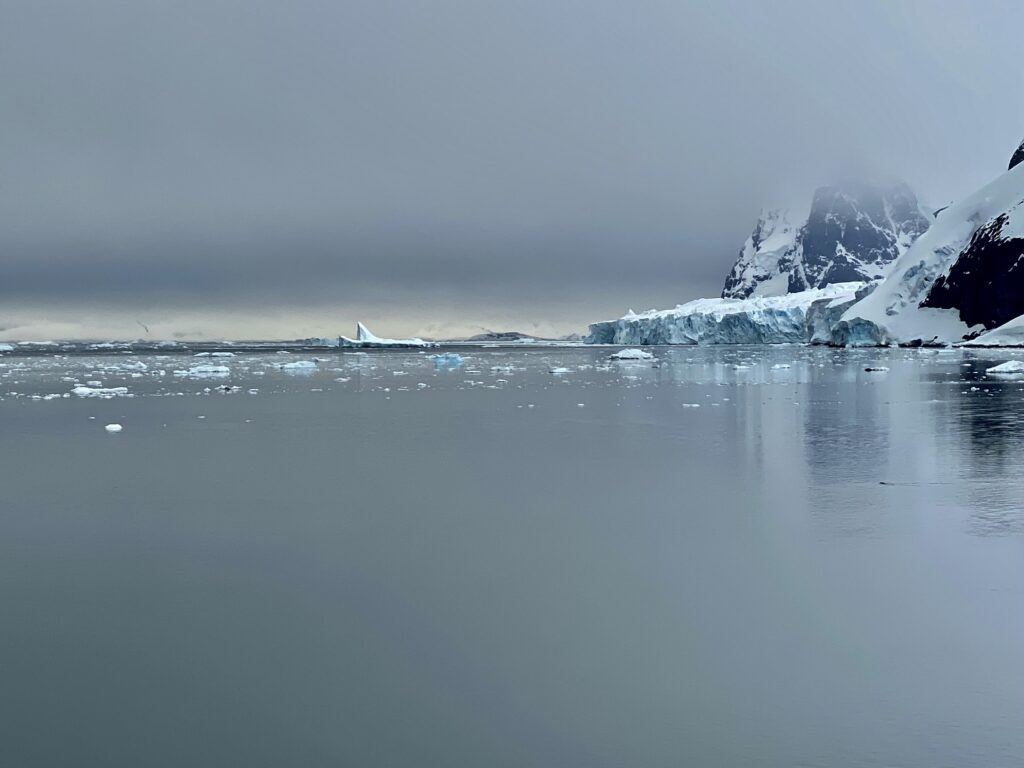
The day finally arrived for our much anticipated Seventh Continent trip. It’s the seventh for me and the sixth continent for Corey.
(Corey went to the Canary Islands last year, which are off the coast of Africa, but we have decided that islands do not count. So when we reach South Africa next year, we together will have traveled to all seven continents over a two year span!)
The whole experience felt so surreal to me.
The Beginning
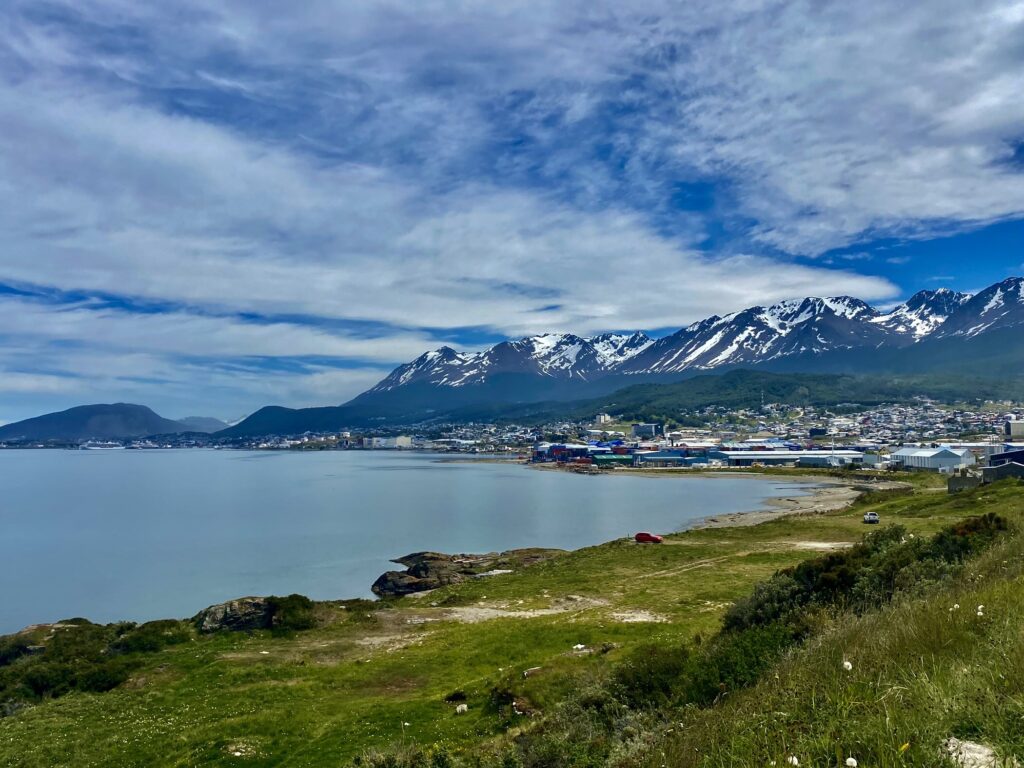
We had made our way to Ushuaia, Argentina on our own. Most of our expedition group had spent a day or so in Buenos Aires and arrived to Ushuaia via a charter flight. Together we boarded a bus at the airport to visit the nearby Tierra Del Fuego National Park, and then took a catamaran ride through the Beagle Channel.
Tierra del Fuego National Park (Argentina)
The bus maneuvered through town, out on the highway, and down the dirt road toward the National Park. As we took in the scenic mountain views, our guide shared history and facts about the area on the bus microphone. The bus was a nice, clean ride with comfy chairs, and we enjoyed the excellent tour.
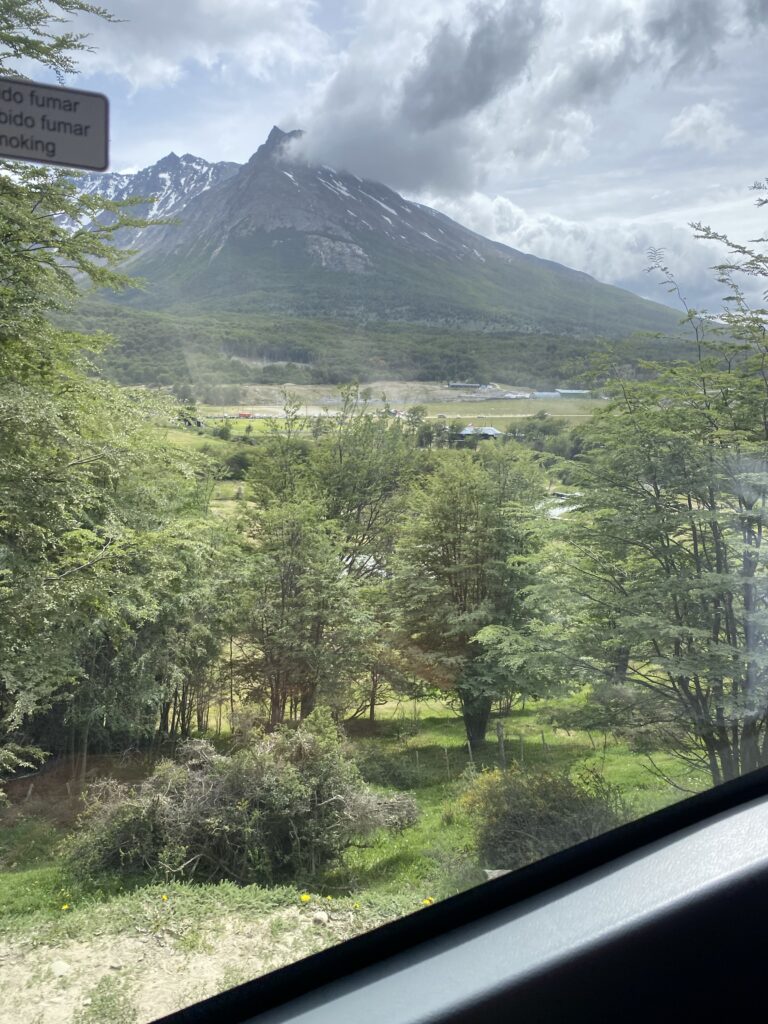
Tierra del Fuego is an archipelago, with one large “main” island, divided between Chile and Argentina. The National Park extends to the border with Chile, and some of the views are of the corresponding park across the border.
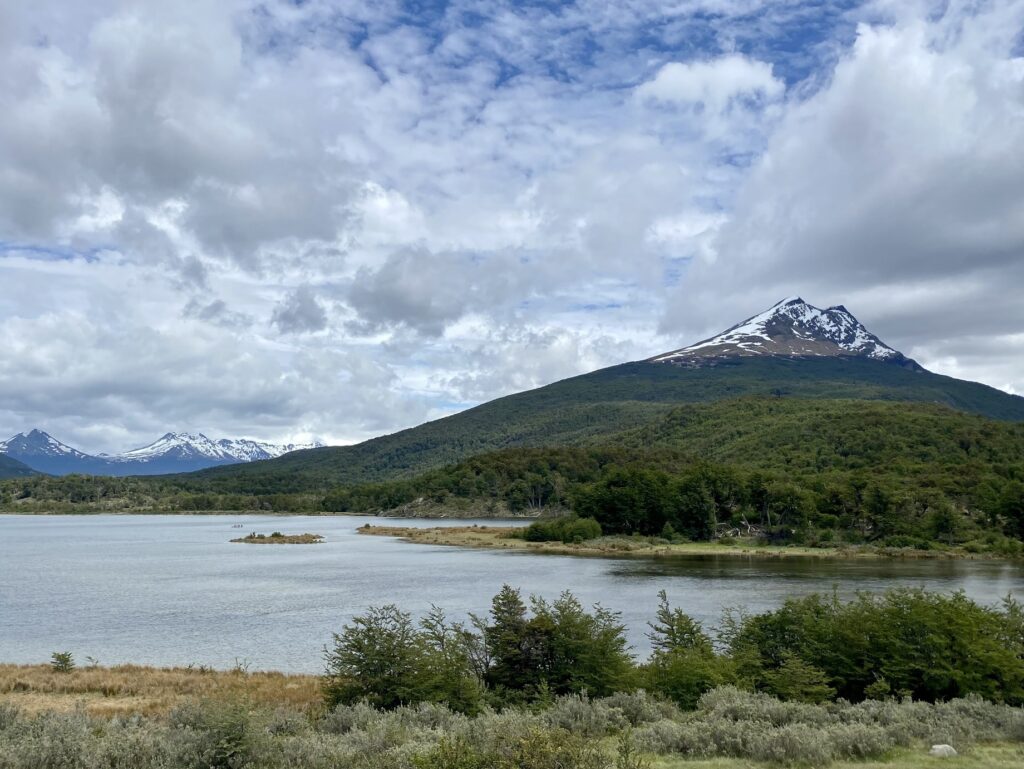
We stopped for 30 minutes at the visitor center. This gave us time to walk through the small museum and grab photos and an empanada.
The bus also made a quick stop at the Acigami Lake then traversed to the end of Argentina’s Route 3, billed as the southern terminus of the the Pan-American Highway.
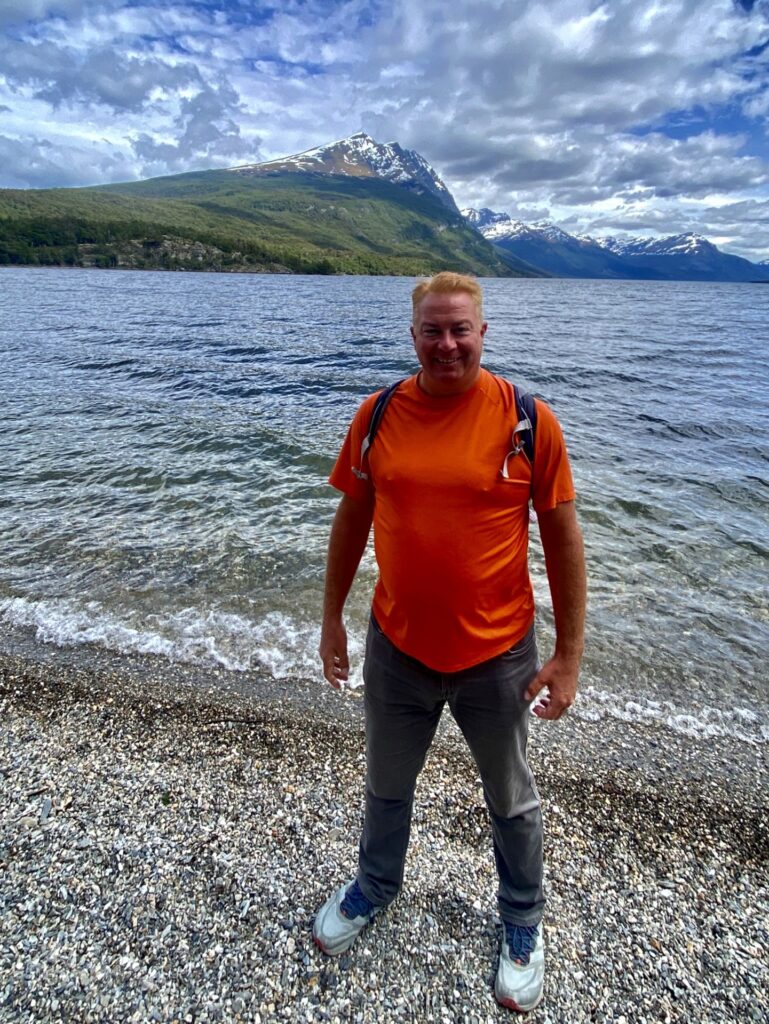
At the same end of the highway we had a nice nature walk and then boarded a catamaran for a lunch cruise through the Beagle Channel. This is the waterway to the south of the main island of Tierra del Fuego, and is another border between Chile and Argentina.
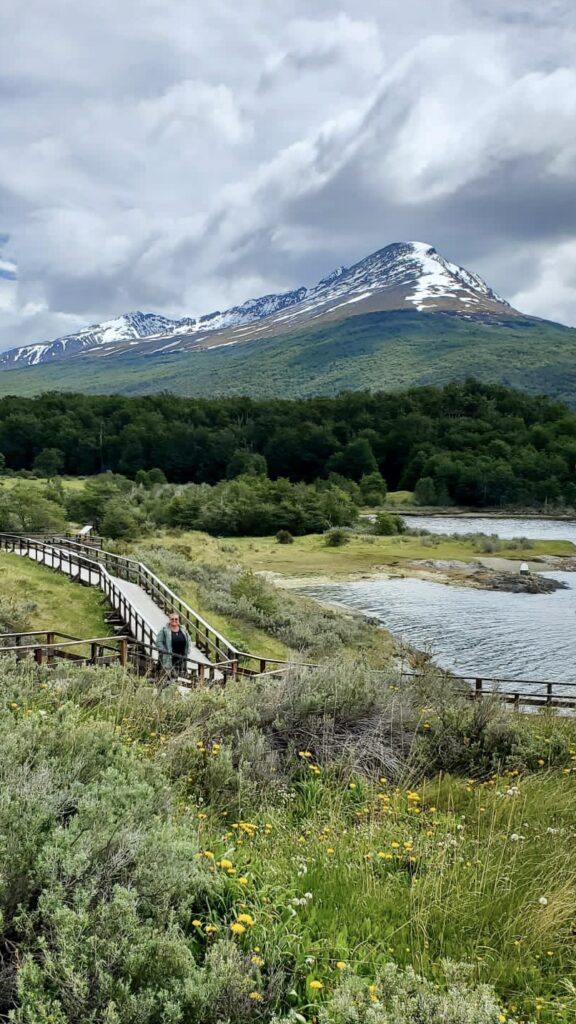
Beagle Channel
The Beagle Channel is one of the two inland routes to avoid sailing around Cape Horn at the bottom of South America. (The other being the Strait of Magellan.)
A lovely three course lunch was served as we cruised around the islands located in the Channel. We had opportunities to acquaint ourselves with our fellow passengers.
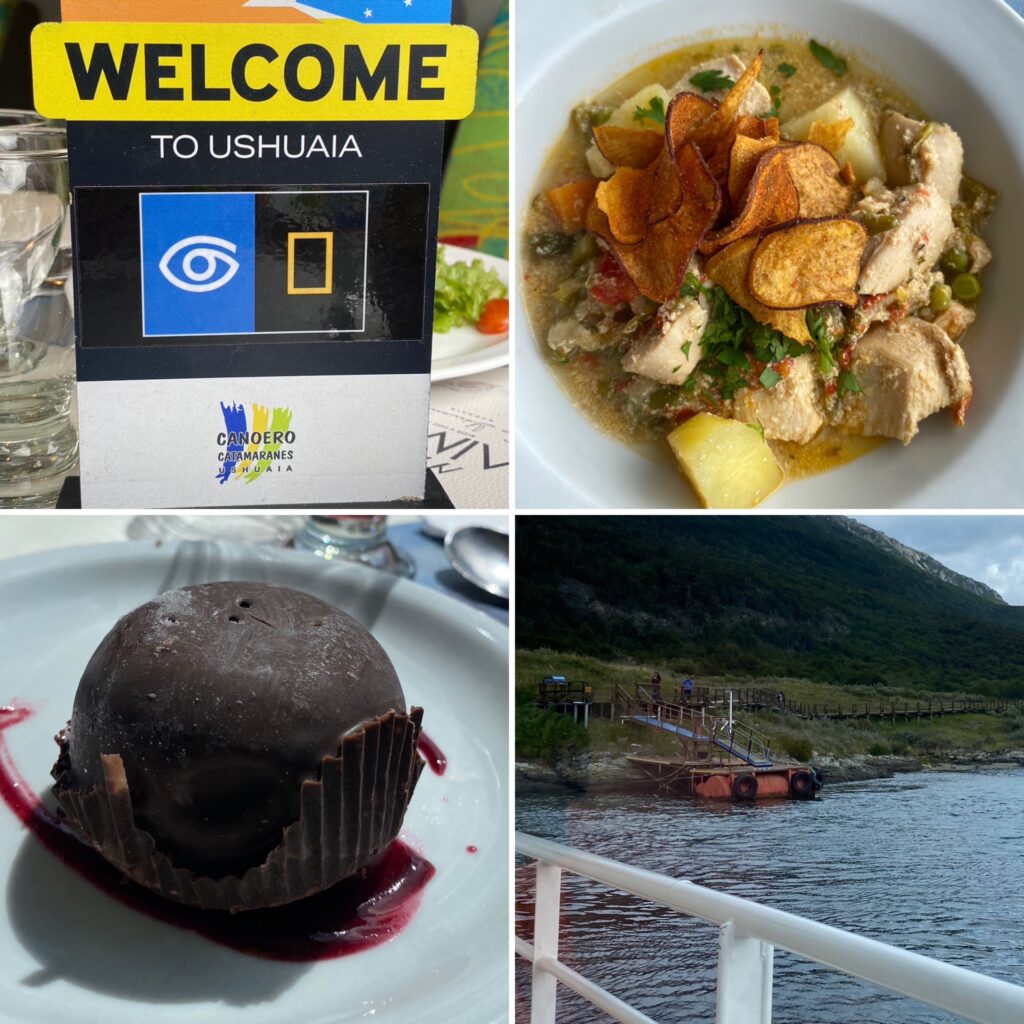
Who doesn’t love a pre-cruise cruise? The highlights were the views on a gloriously sunny afternoon, and the opportunity to see seals and cormorants.
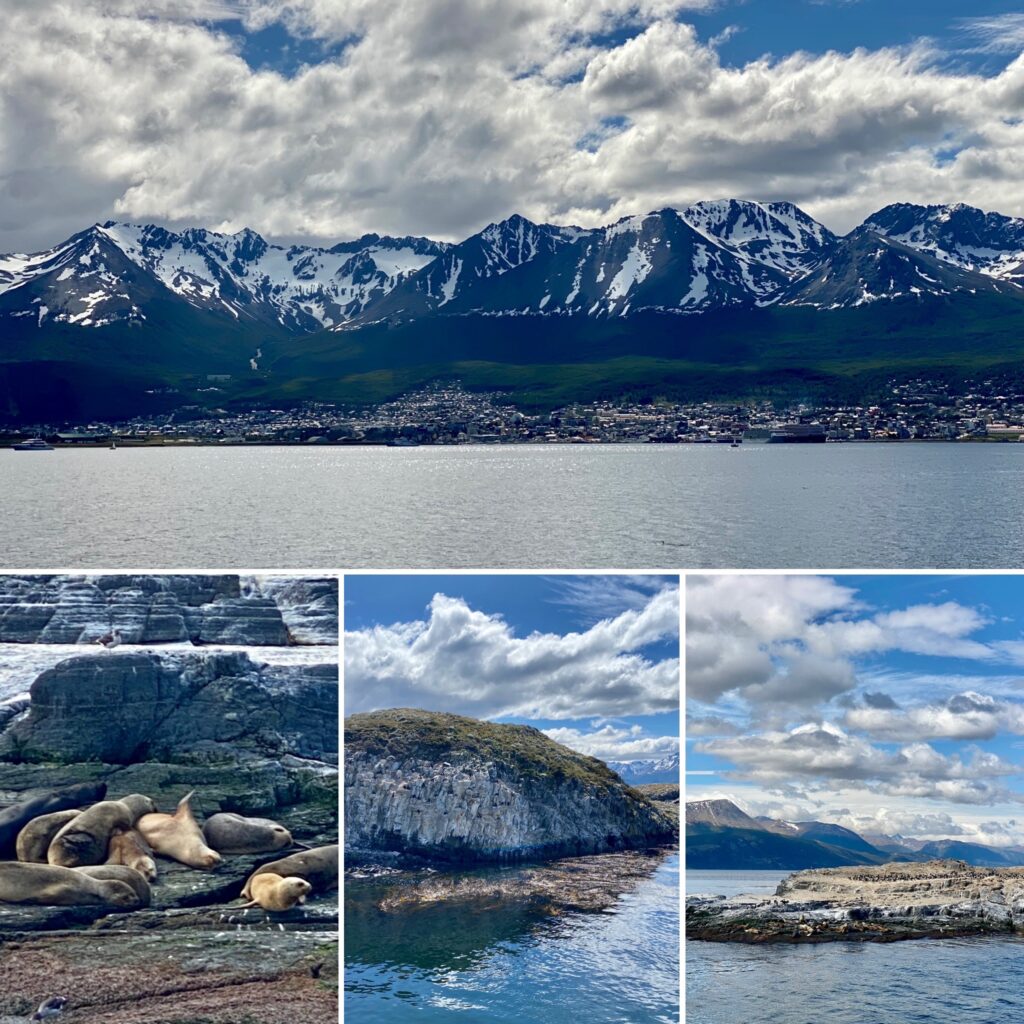
The catamaran ride eventually ended at the main dock in Ushuaia, where we boarded National Geographic Explorer for the first time.
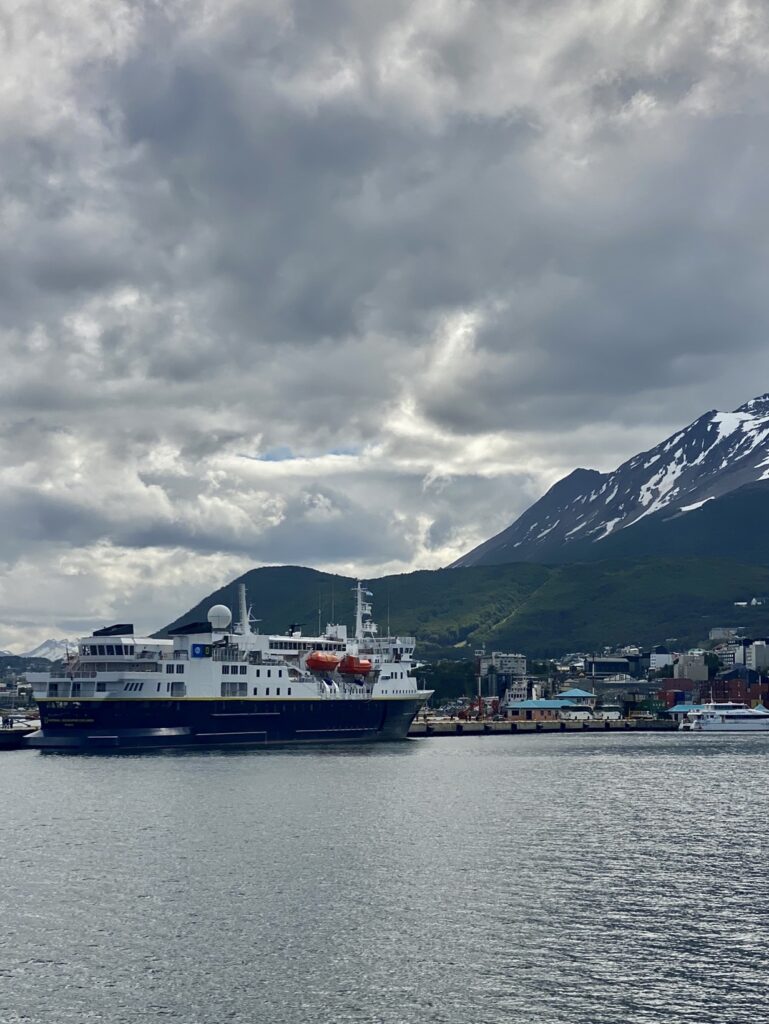
As we walked up the gangway we were greeted by several crew members. It felt like the beginning of an episode of The Love Boat. We were even escorted to our cabin by a crew member!
The Ship
Lindblad partners with National Geographic for most of their ships, although there are certain ships that do not carry the National Geographic branding.

We found the stateroom to be spacious and well-appointed. There is a desk with an atlas to help us chart our course on the map. The bathroom is large with a roomy shower, and high-quality toiletry products are included. There is even a foam-rubber Zodiac boat that can be used to hold toiletries. Here’s a video of our favorite things about the cabin.
Too often, we have looked at the blank walls of cruise ship staterooms and wished that there were more hooks. We now carry magnetic hooks to help with this issue, but it was not a problem on the Explorer. Durable hooks were installed in multiple spots throughout the room, including both sides of the bathroom door. The room was not only larger than a “typical” cruise stateroom, but was better designed to utilize the space. These details matter!
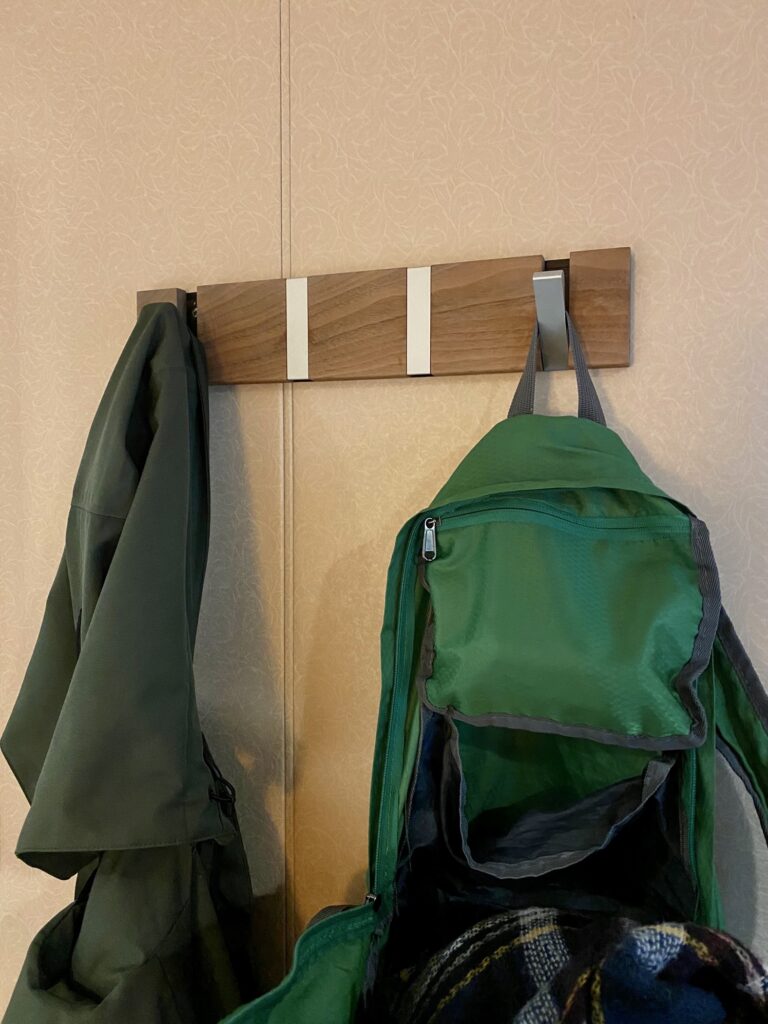
The ship offers multiple viewing areas, but the best one is the panorama from the bridge, which is open at all times (unless safety requires a closure). There is a chart room with coffee, tea and cookies, a library area, and a large lounge where all presentations take place (with draft beer and a large selection of scotch). Meals are served in the dining room and bistro, which offers an additional bar with an espresso machine. The views are generally exceptional throughout the ship, and we spent many hours just staring out of our large stateroom window.
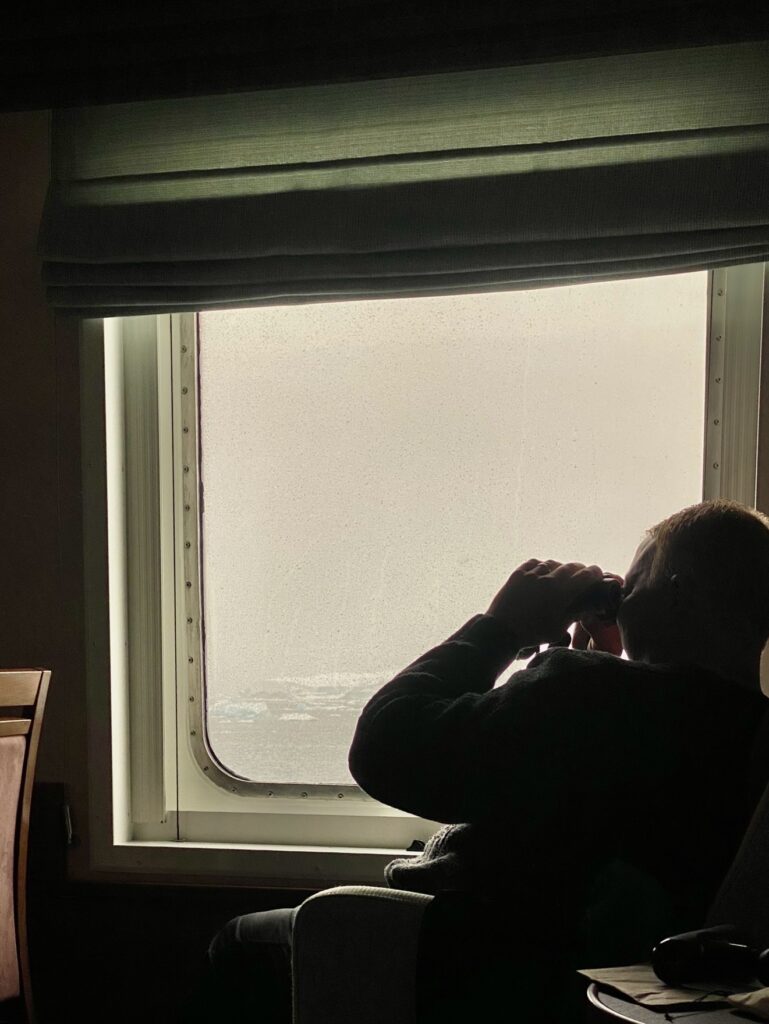
The lower deck of the ship offers additional storage in the “mud room,” where each cabin has a locker for storing and drying goods like muck boots, waterproof pants, or gloves. This is also where we board the Zodiac boats to get to land.
Day 2
Drake Passage
This infamous waterway connects the Pacific to the Atlantic below Cape Horn. There is around 500 miles of Drake Passage for a ship to cover between South America and Antarctica. Depending on the sea conditions, you will either experience the Drake Lake or the Drake Shake.
Why is this area of ocean so variable? At this latitude, there are no land masses to break up storms, so the “memory” of a storm keeps circulating around the globe, creating waves that can toss boats around even when there is no storm in the sky.
Throughout my life, and especially in my cruising career, I have seen videos of ships struggling to sail the Southern Ocean, and specifically the Drake Passage. One ship I worked on had seatbelts attached to the bed to keep guests in bed overnight.
So my awe and understanding of the Drake was high. We exited the Beagle Channel close to midnight and could feel more motion as we approached.
The following day I woke early as we did not close the blackout curtain overnight. I felt woozy all morning and felt best while laying in bed. It wasn’t quite the Drake Lake experience but overall the weather was nice: a sunny day with swells no larger than 10 feet. I was shocked that Corey and I both felt a bit seasick, but the undulating swells were different than what we have felt on our ocean-crossings.
Fortunately, the crossing was complete after around 36 hours, and we made our first landing the very next day.
Day 3
Barrientos Island, South Shetland Islands
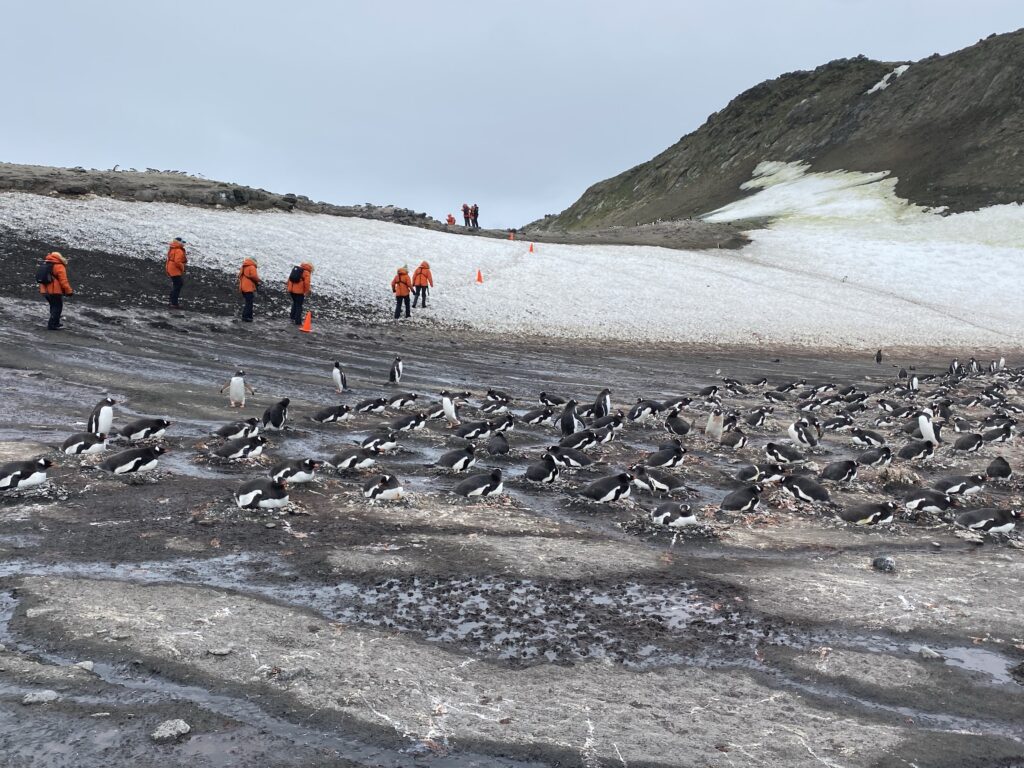
Are you ready to see some penguins? I certainly was, and our first stop put us on a beach right next to a large rookery of penguins. There were penguins waddling around everywhere! The stationary ones were laying on eggs, protecting them from the nearby skua birds.
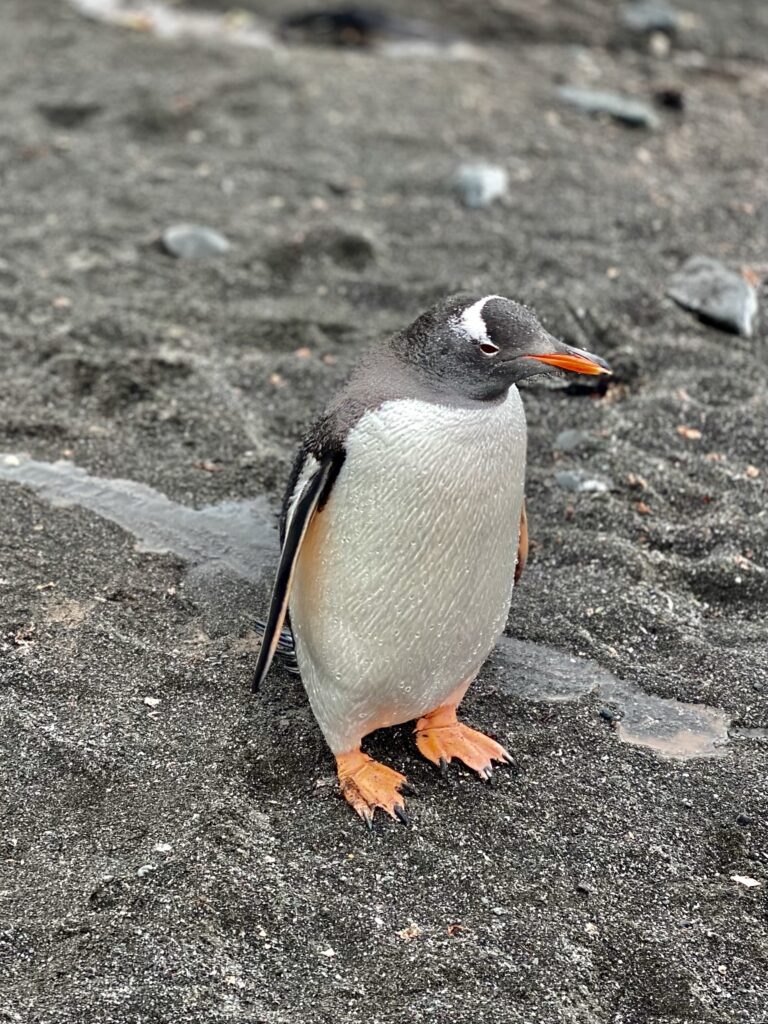
After a short and blustery ride on the Zodiac boat, Corey and I walked along the trails that were marked with traffic cones, being careful to always stay five meters away from the penguins. We each found a favorite vantage point to observe these adorable creatures and the funny things they do, like stealing rocks for nest building, slipping on ice, and jumping into the sea. Here is an Insta video with a summary of the day, including lots of penguin shots!
The current threat of bird flu (aka highly pathogenic avian influenza) is an overarching concern. Bird flu affects wild birds and domestic poultry. Despite the name, it can spread to mammals including seals humans. It has not yet made it to the penguin colonies on the Antarctic continent, but it has infected skua birds in the surrounding islands, and skuas travel. For us, we needed to always stay five meters away from any wildlife, but especially the penguins, who have a habit of sneaking up on you. (And we learned later that Barrientos Island has since been closed for the season due to the abundance of penguins and the threat of bird flu.)
This island used to be completely occupied by chinstrap penguins, but now their numbers are declining, in favor of the gentoo penguin. Gentoos are larger, eat a wider variety of food, and are better able to replace eggs that are lost during the breeding season. We never saw the two species directly in conflict with each other, but indirectly, the gentoos are winning the fight for resources and territory as the climate conditions change in Antarctica.
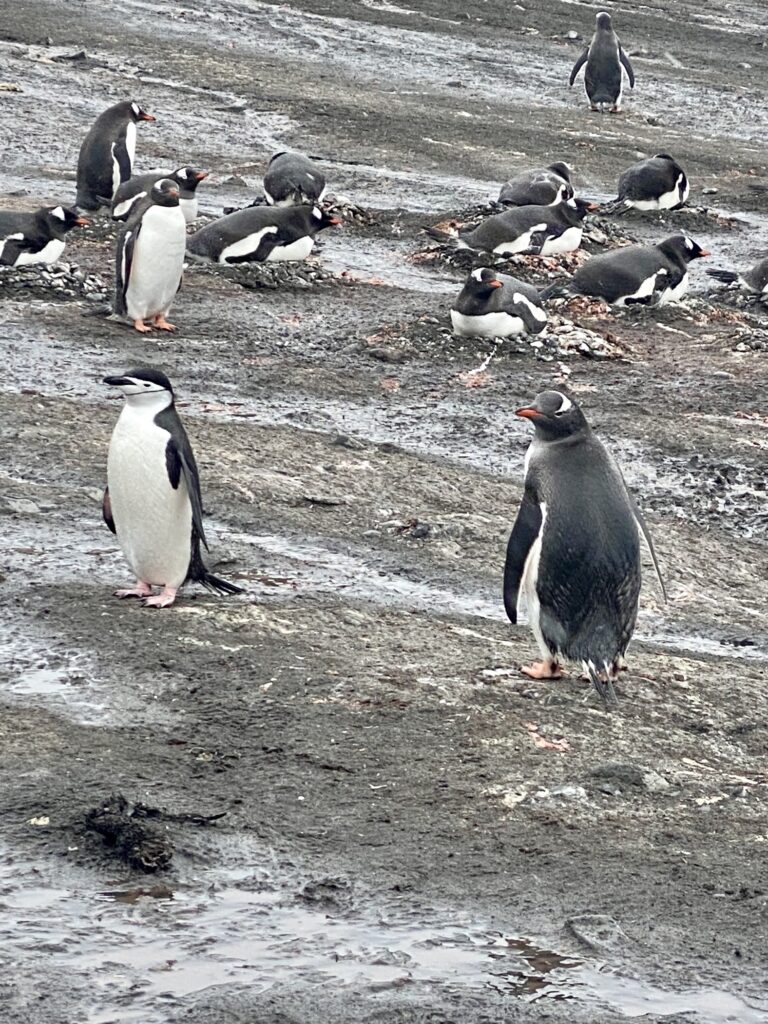
It was a great first landing. The actual landing process is very different than what we are used to with larger ships. Every landing we did was in shallow water! In the mud room, we would change into our waterproof pants and waterproof muck boots. The pants go on the outside of the boots, so any splashing stays out of the boot! Stairs from the mud room lead to a platform on the side of the ship, where the Zodiac is tied up. Boarding is assisted by multiple crew members, making it a relatively simple process. Sitting balanced on the sides of the Zodiac was similar to how we sat on the inflatable rafts in the Grand Canyon, although our guide used an outboard motor instead of oars (thankfully). On arrival, the boat pulls up onto the shores, and we wade the last few feet, thankful that our boats are both waterproof and insulated.
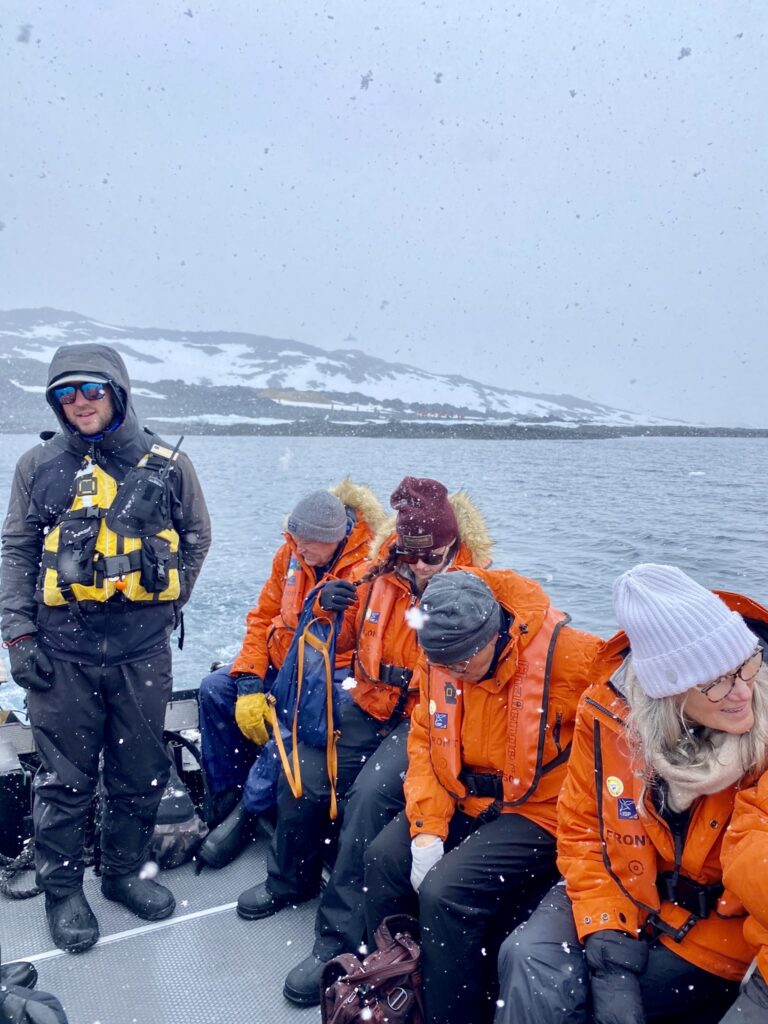
Back on the ship, in the mud room, we carefully clean and decontaminate our boots and pants, so that nothing we pick up from one area is transferred to the next. Then we can go warm ourselves up!
Day 4
Paulet Island
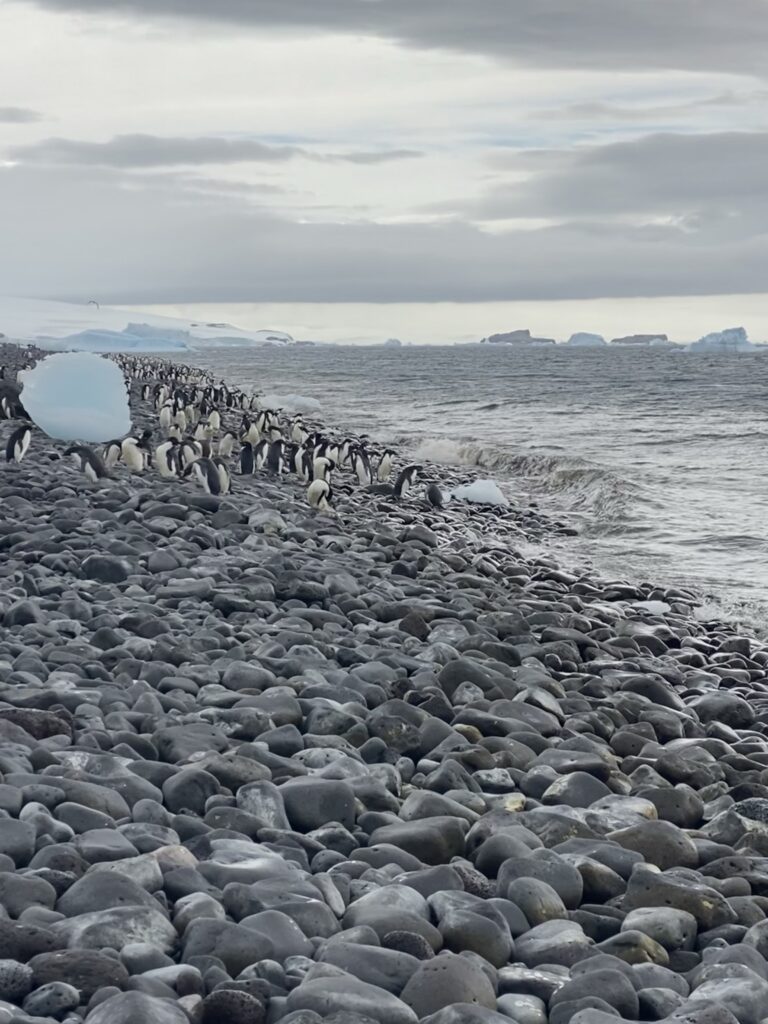
We get closer to reaching Antarctica proper. Paulet Island is a very small island about 30 miles east of the Antarctic Peninsula, with an abundance of Adelie penguins, the third and final penguin species we will see on our voyage.
In 1903, following the sinking of their ship, 20 men from the Swedish Antarctic Expedition spent nine months in a stone hut on this island. They survived by eating the Adelie penguins and their eggs. The ruins of the stone hut can still be visited, along with the gravestone of the one explorer who did not make it through the winter.
For us, the weather was uncooperative, and we landed at an alternate beach away from the historic site. With so many penguins, it was deemed impossible to walk the longer walking loop that goes to the hut, while still providing the necessary buffer for the penguins. (Again, being extra-careful due to bird flu.)
The passengers were divided into groups so that the mudroom was never too full. On this day, we were in the last group to be called ashore. I spent all morning rethinking my outfit. Yesterday, with three pairs of pants on, I felt like a walking potato. But I also wanted to keep warm! The ambient temperature was never that bad: hovering around 30 degrees F, it was warmer in Antarctica than many parts of the United States. But the polar winds cut with a bone-chilling rage, especially as we speed through the sea on the Zodiac boat toward the island.
Large round stones filled the beach. The Adelie penguins were nesting above the high tide mark. They looked different than the other penguins. They had beady steel-colored eyes and squawked a lot less than than the gentoos.
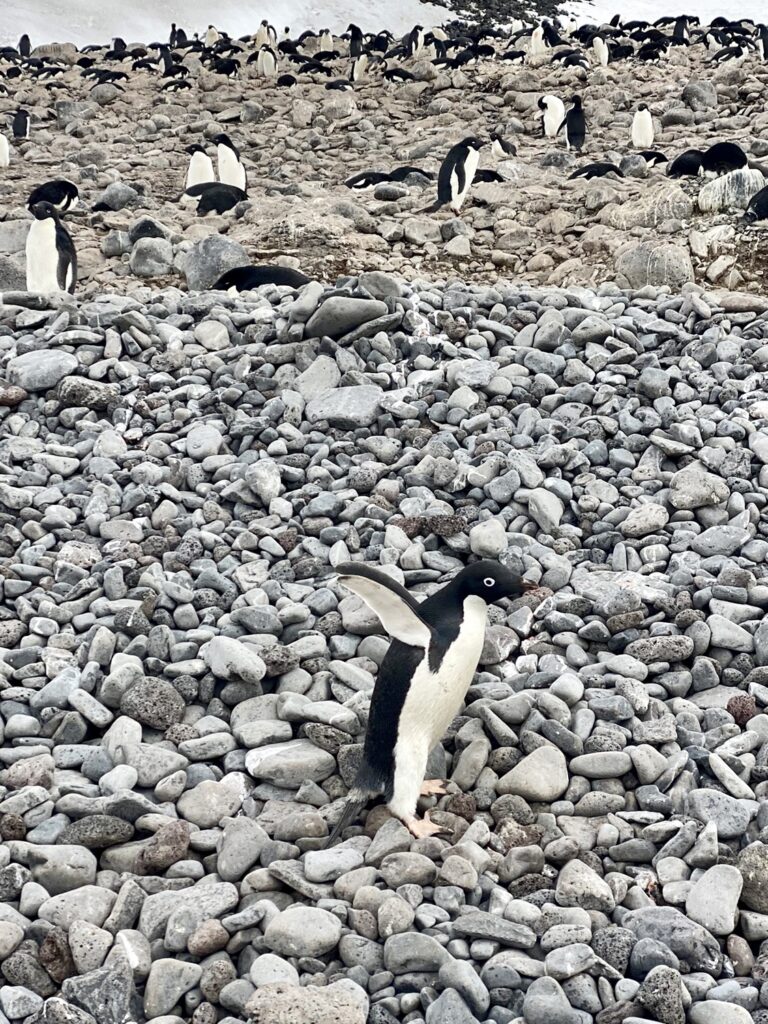
I loved watching them climb up and down the beach before and after going fishing in the sea. At times dozens would gather in a crowd, staring at the waves. It looked like they were working up the courage to dive into the ocean together.
A Weddell seal was also resting on the beach. The penguins were not bothered and walked around it. Weddell seals are very large and spend most of their time swimming and eating. We always saw them resting because that is what they do when not underwater! Here is a video of the highlights from the morning.
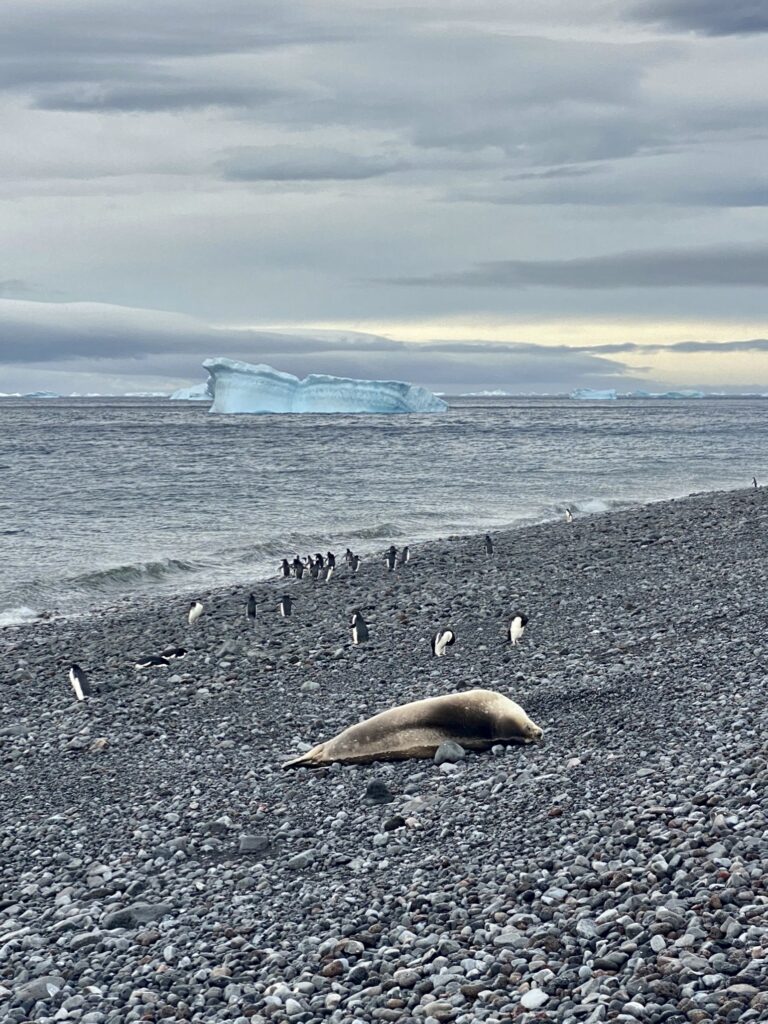
Brown Bluff
This was scheduled to be our first landing on the continent, but harsh westerly winds spoiled those plans. We moved on under the moody skies.
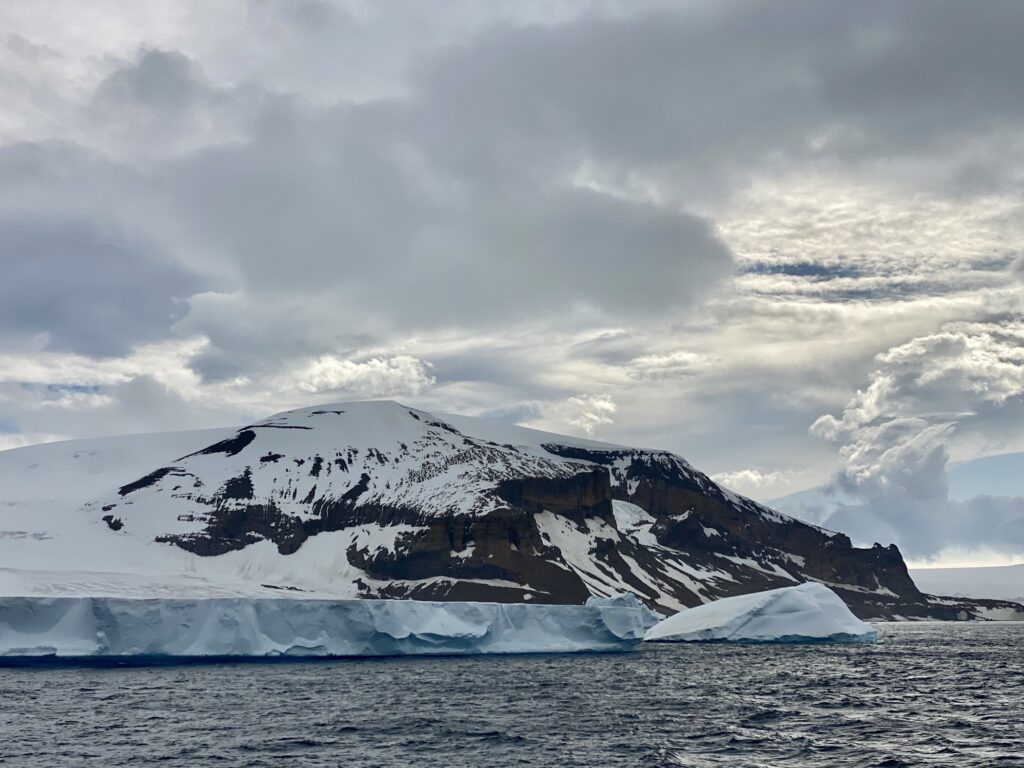
Hope Bay
Plan B: Take the Zodiac boats out for a cruise in nearby Hope Bay. But with the wind blowing at 40 knots, it was not safe to do that, either. So we settled for Plan C: stay on the boat and cruise.
Scenic Cruising
We circled around the bay slowly, looking at the wide and flat tabular icebergs. The coolest one was about 100 feet tall and 1 mile long. These are icebergs that calve off of polar ice shelves, creating large islands. Less-dense than the typical iceberg, about half of their surface area is above the water surface.
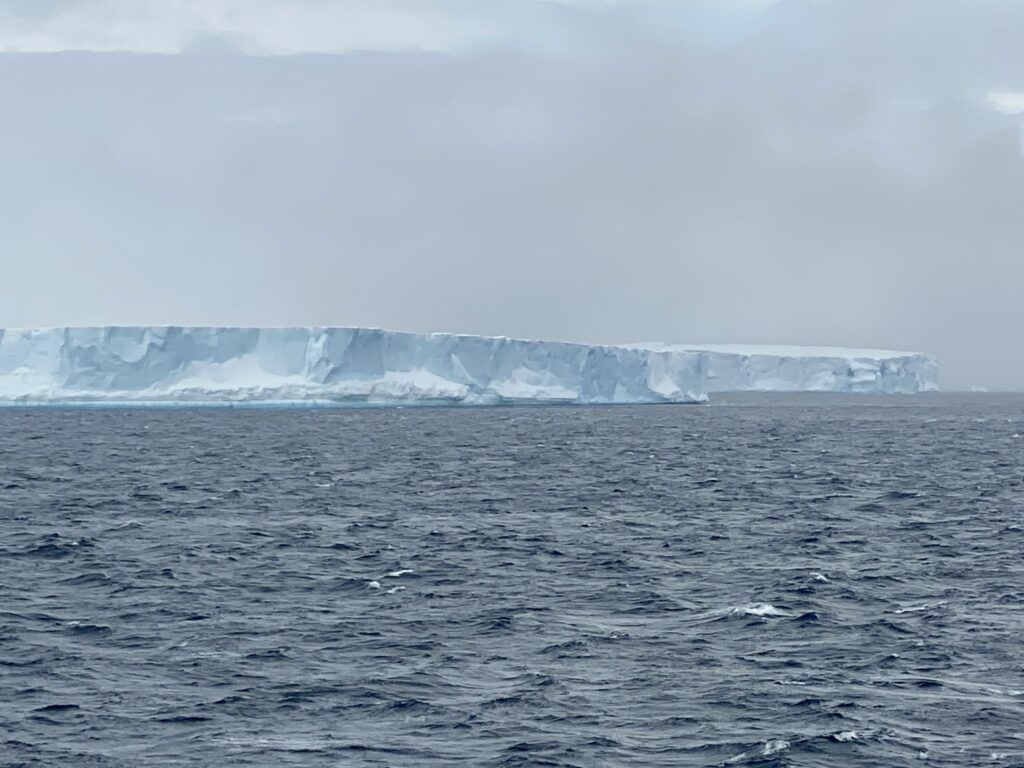
From there the ship cruised north, between the east side of the Antarctic Peninsula and Ross Island. We spent time going through Iceberg Alley, with incredible views all around. Icebergs tend to get funneled here by the ocean currents. Corey and I went up and down stairs, forward and aft, to keep finding different and spectacular views of the various icebergs. I also learned a new phrase: bergy bits, the small fragments of ice that are not large enough to be considered actual icebergs.
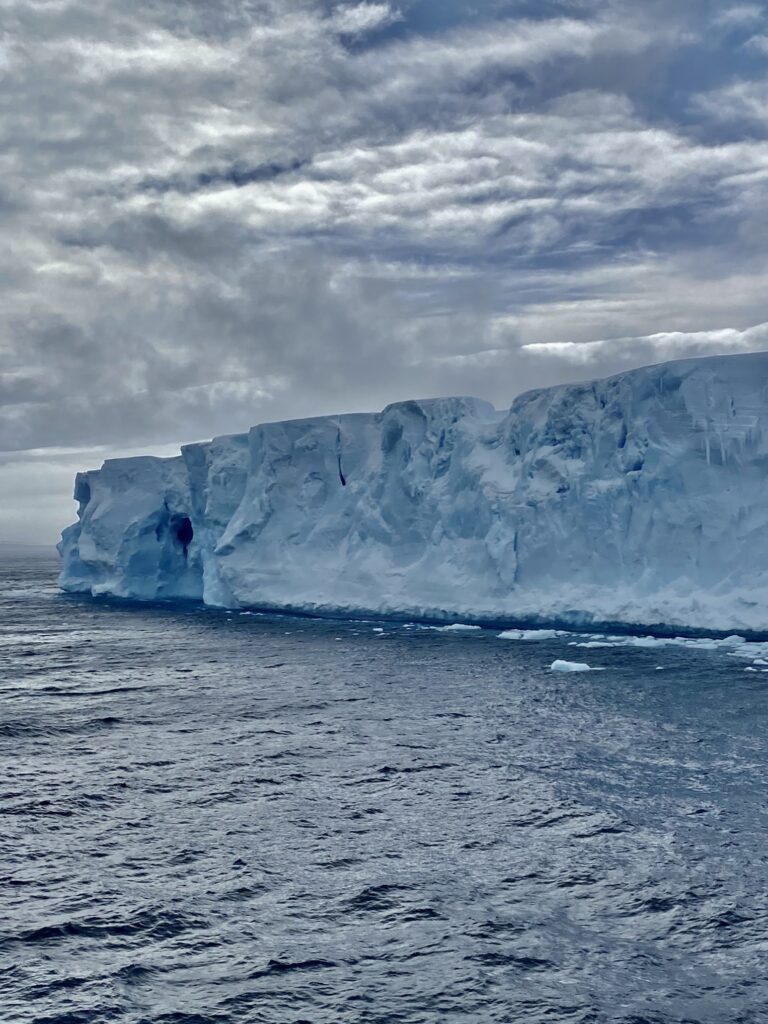
We continued sailing around Ross Island and into the Weddell Sea, all just east of the Antarctic Peninsula.
The day got even more amazing with a post-dinner sunset and ice extravaganza. We sat in the lounge and ran outside to grab photos and videos of the gorgeous sunset colors.

The ship also proceeded into a bay of ice during sunset. It was a wonderful day, watch this video of the highlights from the second part of the day.
Day 4
Pitt Point
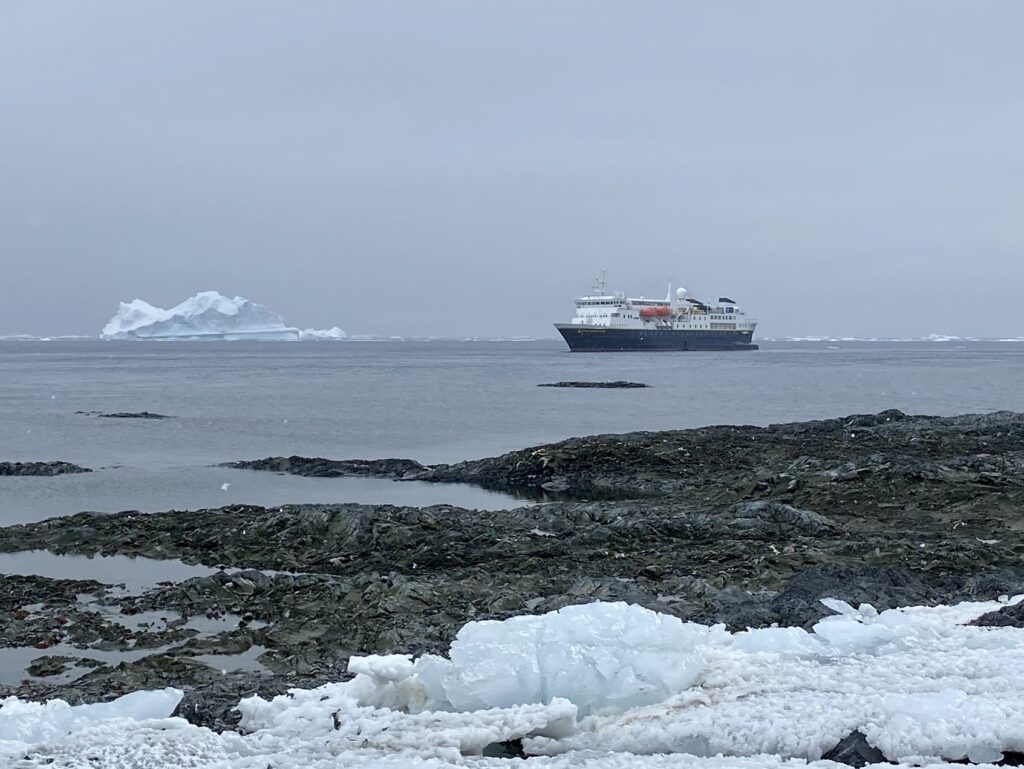
Finally, we made it the Antarctic continent! We have mentioned the Antarctic Peninsula before in this post. This is a tendril of land that points north toward South America, with Cape Horn pointing back. Most visits to Antarctica, including ours, explore this area and the various islands that surround it, as these are the most-accessible areas of the region.
Pitt Point is a beach area on the east side of the Antarctic Peninsula. As we landed, large snowflakes fell on and around us. The beach was rocky and devoid of penguin nests. I spotted one or two penguins off in the distance but it was nothing like our first stop at Barrientos.
Corey took the option of a short hike while I observed a plump Weddell seal laying on the beach, digesting his meal. Corey hiked up about 15 minutes to see a fresh water “lake” and the remnants of an old base, including an abandoned sledge (basically a large sled).
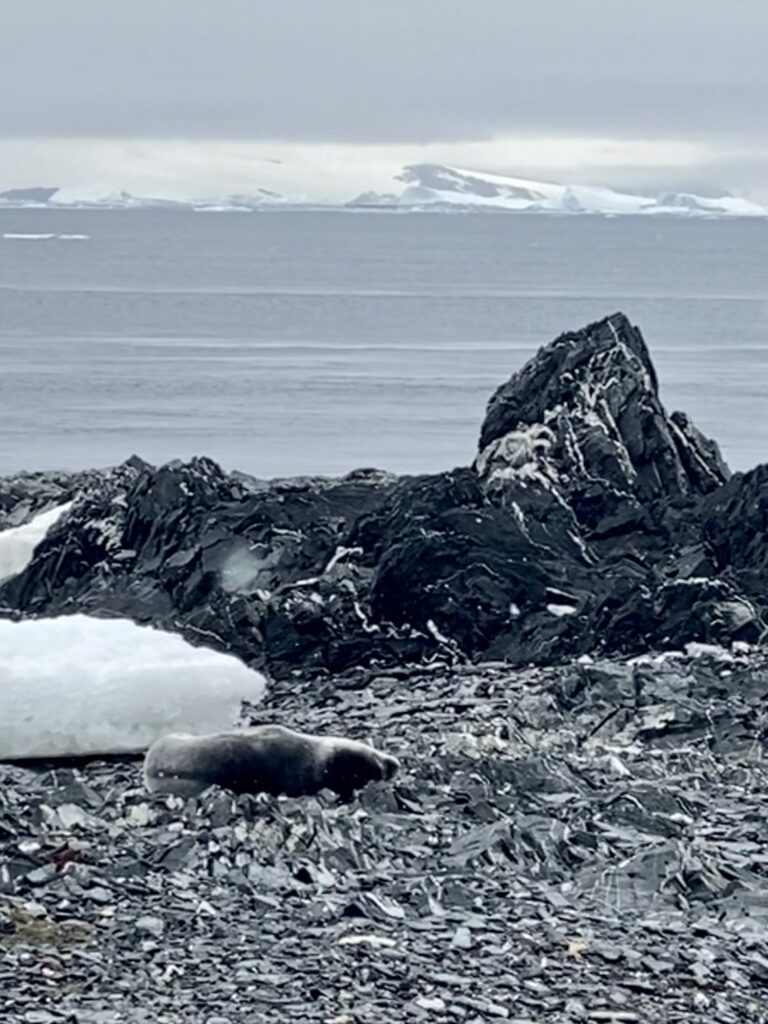
While on the beach, I also saw two pairs of penguins, and Arctic terns hovering just above the ocean looking for food and swooping through the skies.
The rocks on this beach were different from the round stones or sandy beaches we had already encountered. The rocks were sharper and jagged and we later learned back on the ship they were were shale and quartz. The geology changed so much from landing to landing, and I liked comparing and contrasting the land and sights and animals.
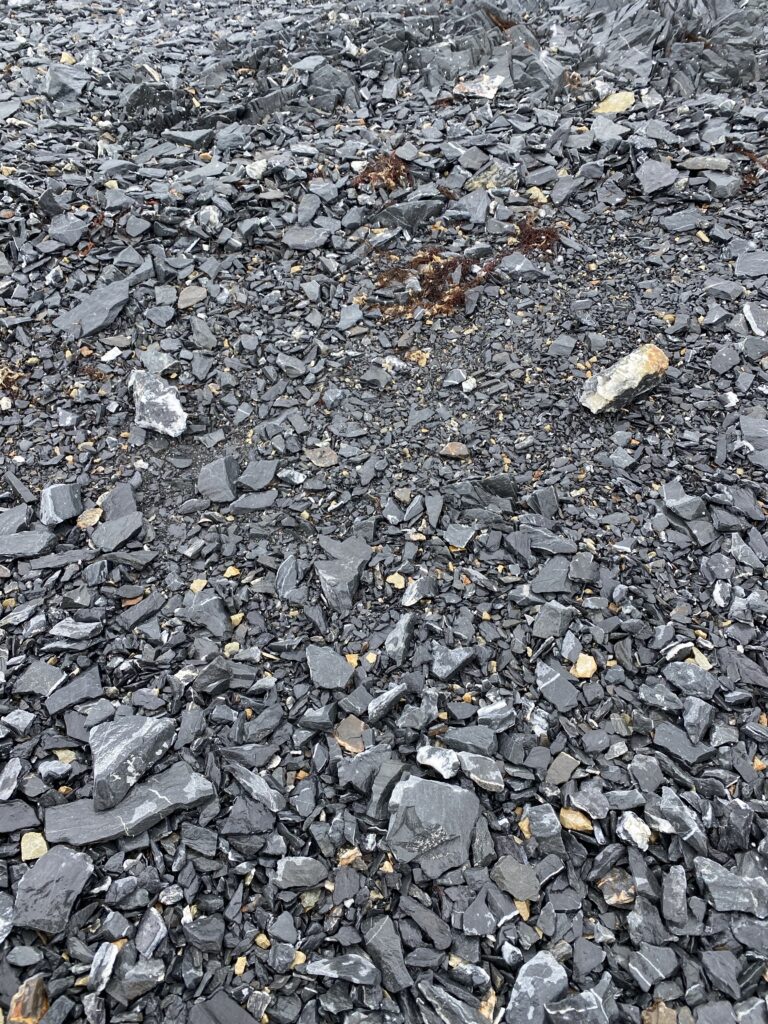
While we were taking the Zodiacs back to the ship, I noticed a leopard seal swimming near the beach. We later learned that the dive team does not enter the water where leopard seals are present. They are usually cooperative but they are considered an apex predator and have been known to mistake divers for prey!
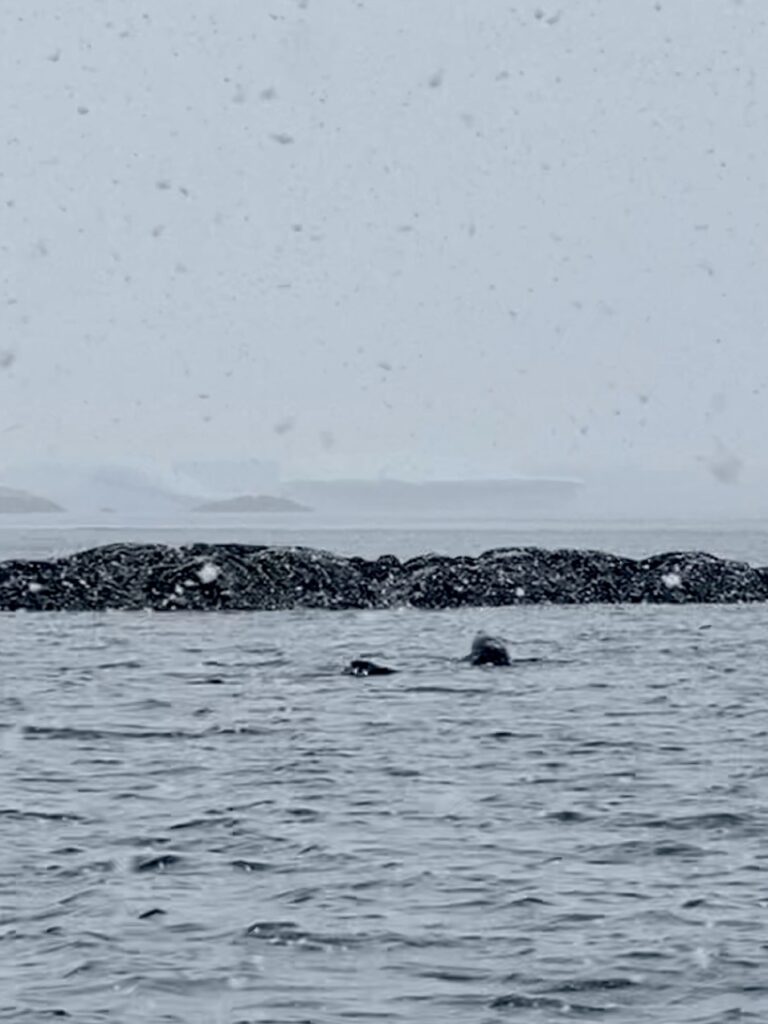
After sailing away, lunch was served, with a large pod of orcas showing off through the windows.
Later on, tea was served on the aft deck. Was a treat! It wasn’t just tea but grilled steak sandwiches with fresh chimichurri. The outside deck views were fabulous for watching penguins dive in and out of the waves, and the birds soaring through the sky. We also spotted a cruise ship tucked into a bay in the distance.
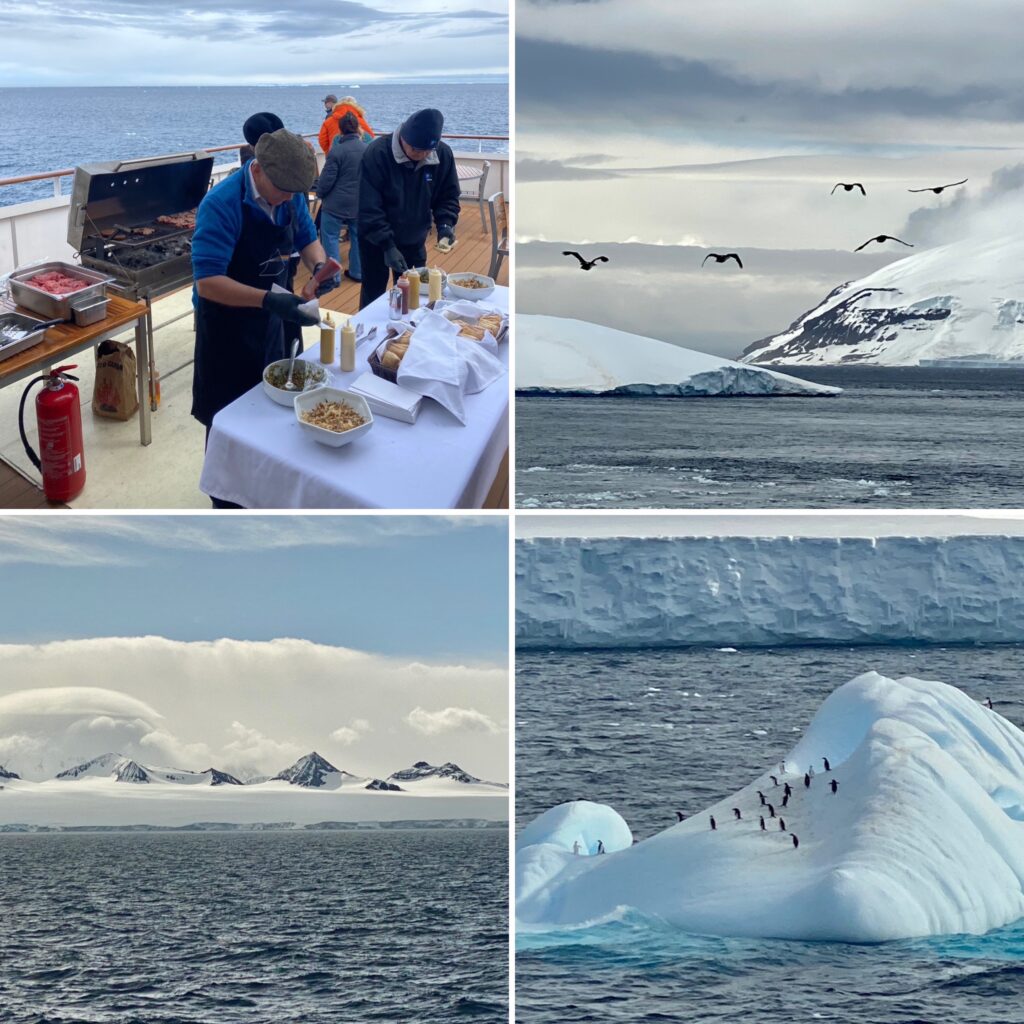
The photo below shows the scale of the mountains around Antarctica. Can you see the large cruise ship?
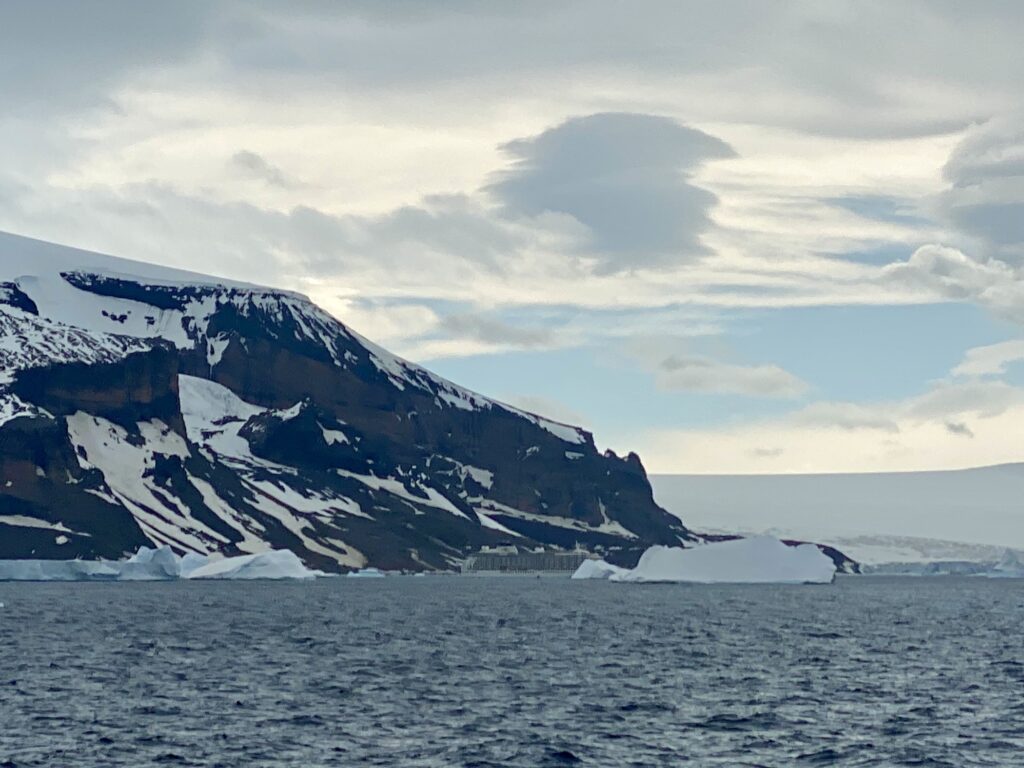
We also passed by some of the same amazing icebergs we cruised past before. They were still incredible to see especially with some blue skies. Watch this video to see the highlights from this day.
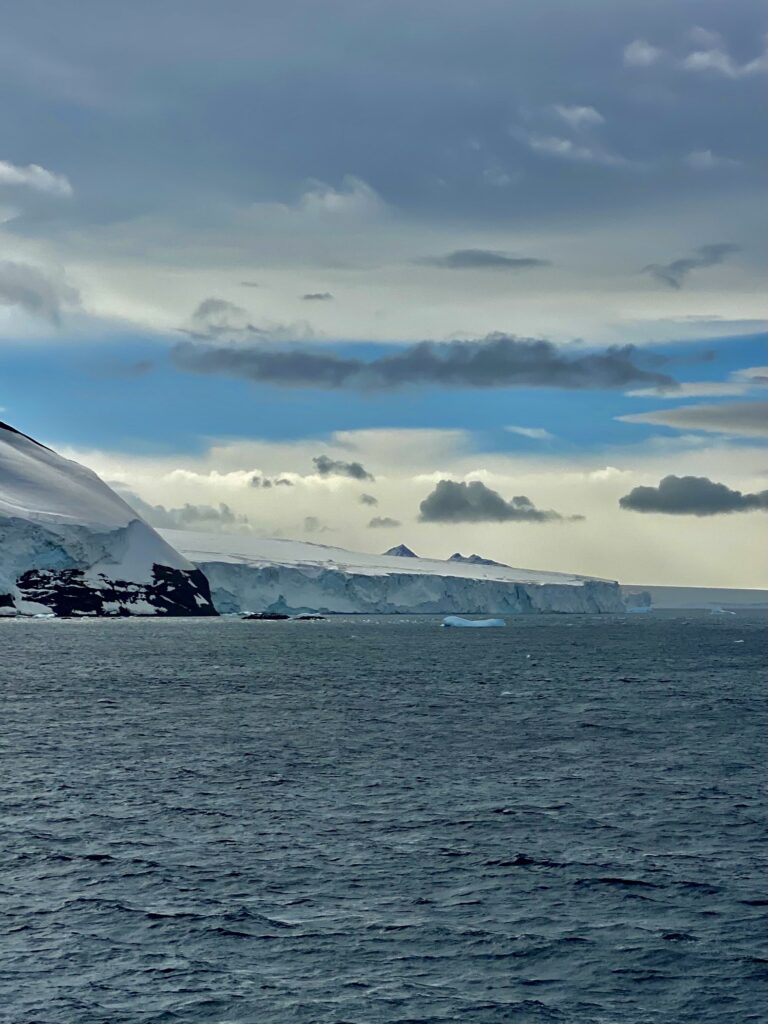
Day 5
Overnight the ship sailed from the east side of the Antarctic Peninsula to the west side, where we would spend the next few days. I didn’t think the scenery could get any more spectacular than the last few days, but I was wrong…
Cierva Cove
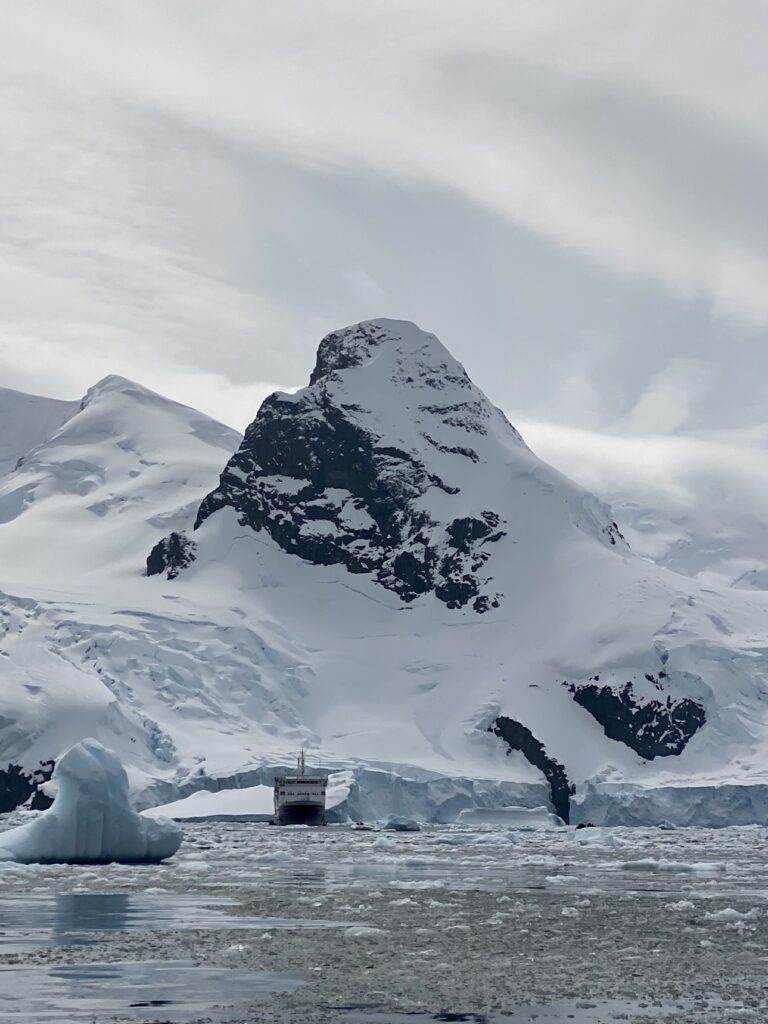
The view from our window showed the Zodiacs ready to take the first group ashore. Not us, not yet. Half of the ship stayed onboard for scenic cruising into the cove. We enjoyed views from the bridge and bow.
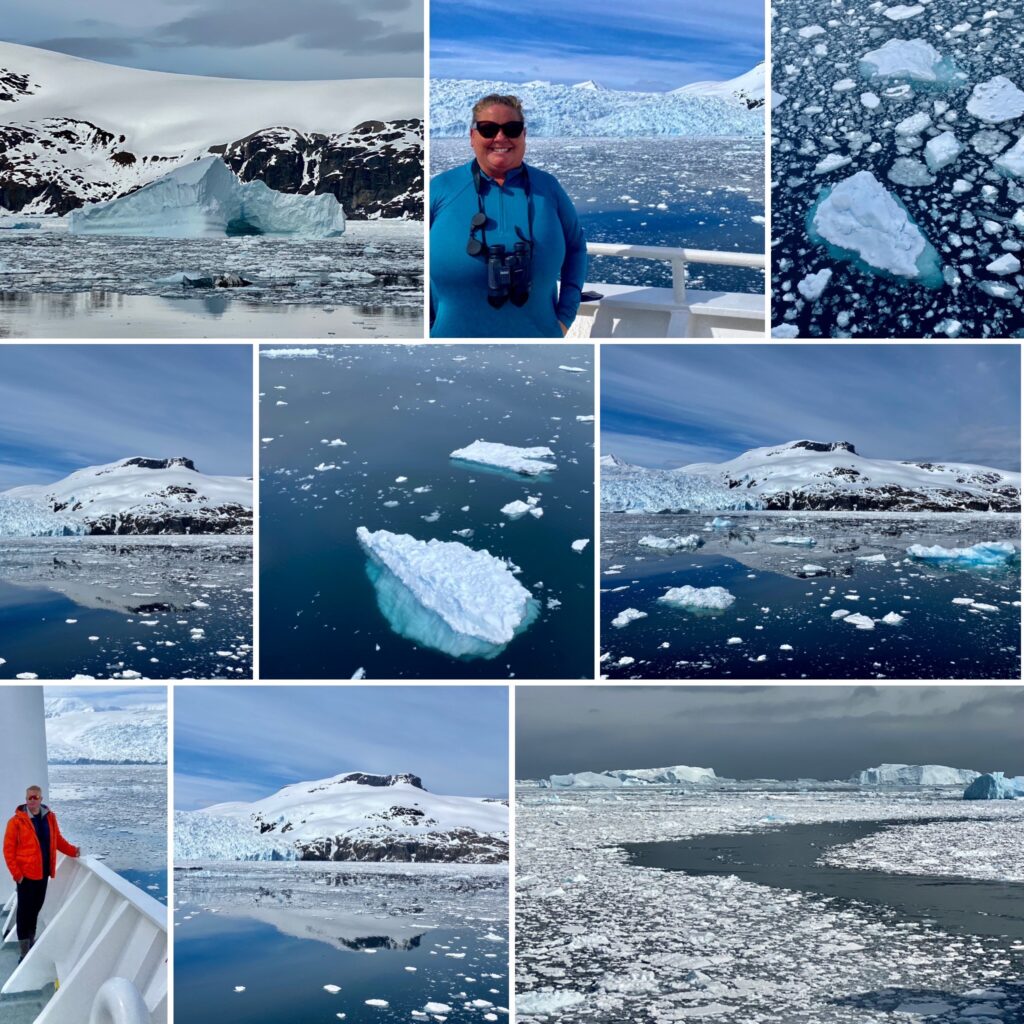
As the ice chunks slapped against the sides of Explorer it would make funny sounds and folks onboard would cheer. It was a fun morning with rewarding views of the glaciers dripping into the sea. It is hard to comprehend how much ice there is. After getting as close as safely possible, the ship turned around and made its way back to the original position.
Check out this video of Corey acting as the worst scenic navigator ever.
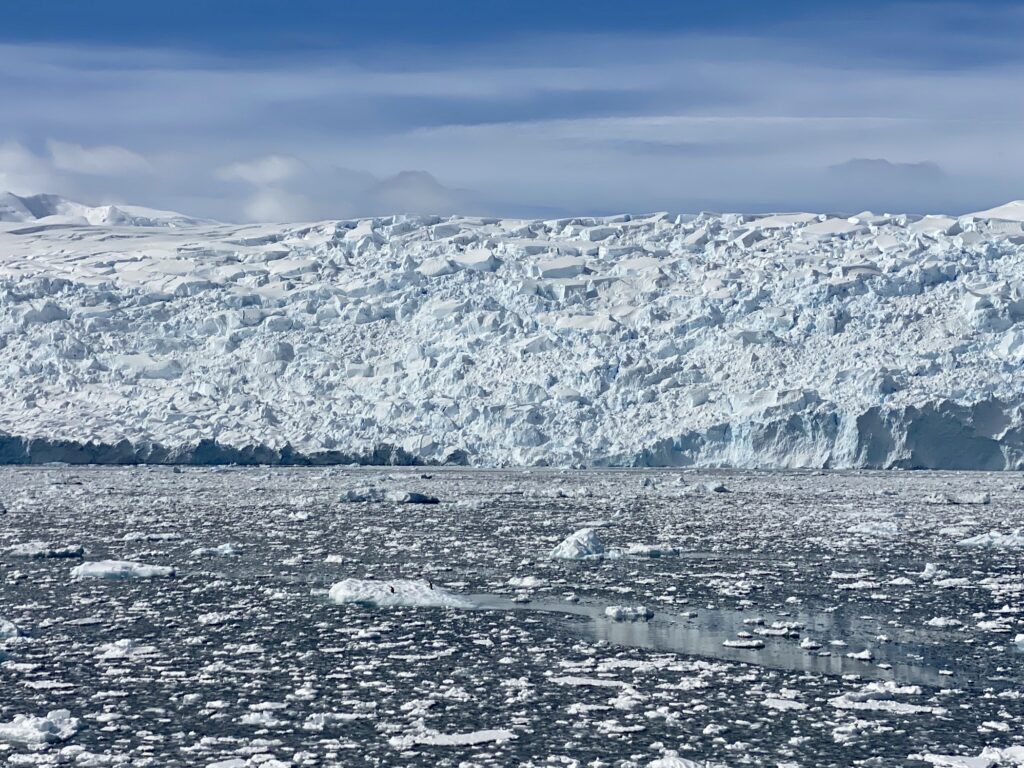
Eventually it was our turn to take Zodiacs out to explore. We saw a humpback whale, penguins, lots of icebergs, and then a ship of vikings appeared! They were friendly though and offered steaming mugs of hot cocoa.
The Zodiac cruise was just shy of magical. The blue ice dazzled in the light. Penguins jumped out of the water. Brooke, our Zodiac driver, took us on a journey to visit an iceberg arch way off in the distance. Only one other zodiac joined us out there. Pictures cannot show the enormity of this arch!
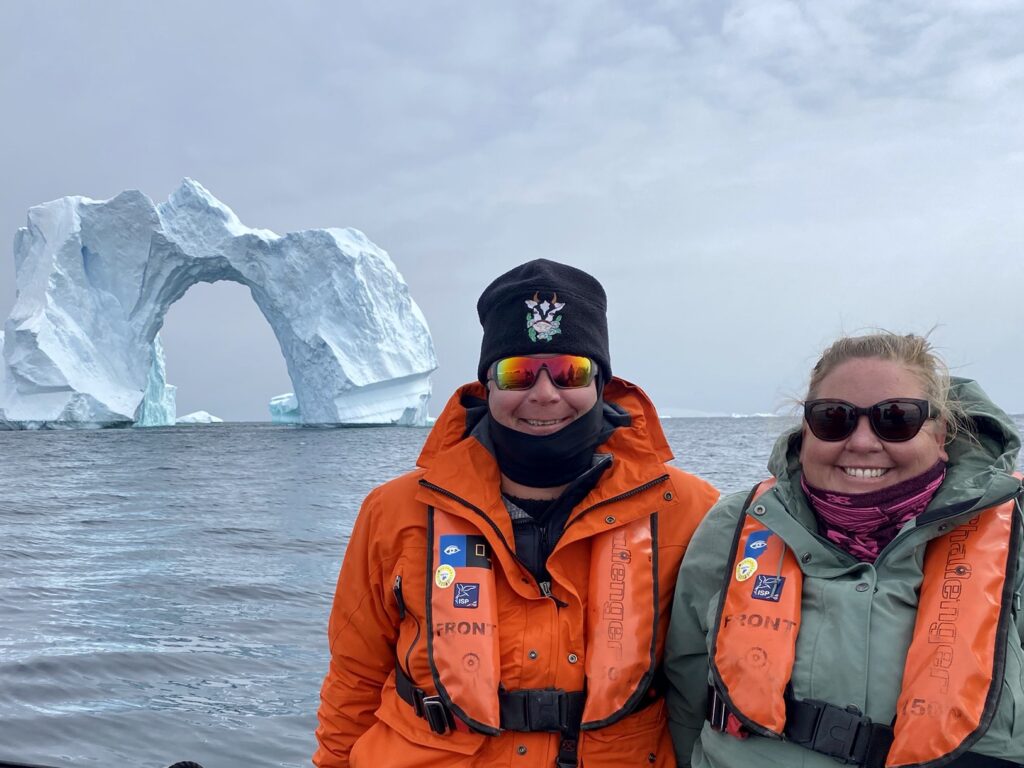
We also cruised by a penguin colony and watched them gracefully (and not so gracefully) make their way up and down the steep slopes.
While we were out in the Zodiac boats, the guests on board went on the same scenic cruise that we had in the morning. Then we returned to the ship at the designated meeting point, where we had lunch as the ship repositioned to the adjacent bay.
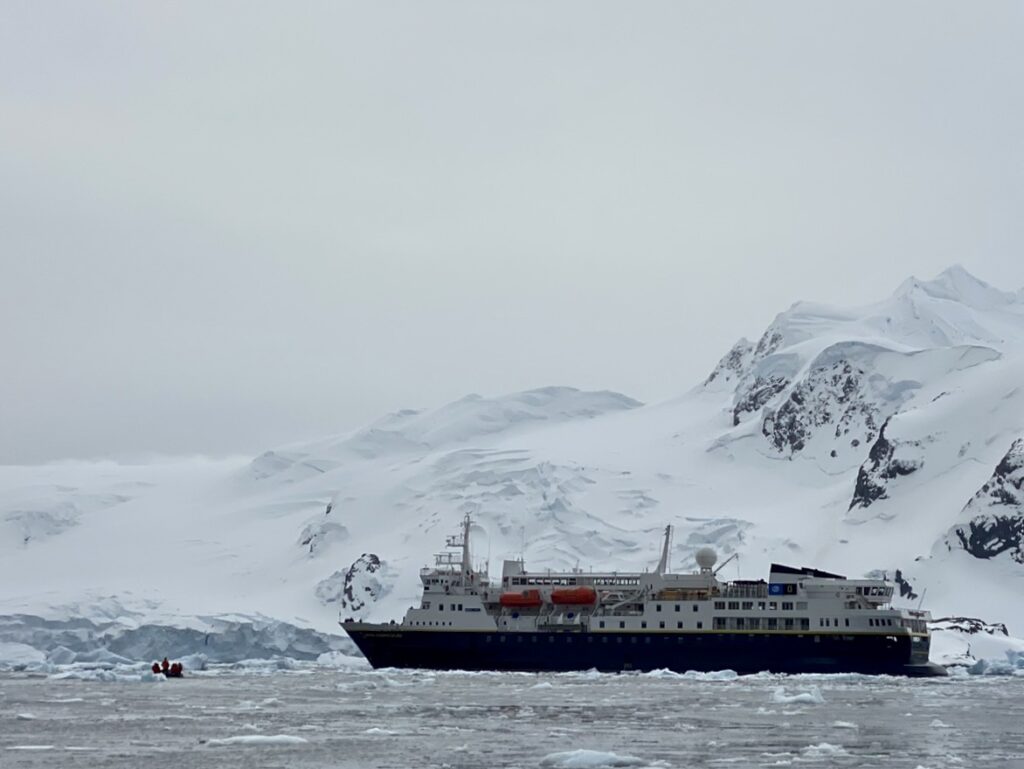
Here’s a video of the morning highlights in Cierva Cove.
Curtiss Bay
Kayaking was offered to all guests who wanted to paddle in Antarctica. We weren’t particularly excited about kayaking in Antarctica but we weren’t going to turn down the opportunity!
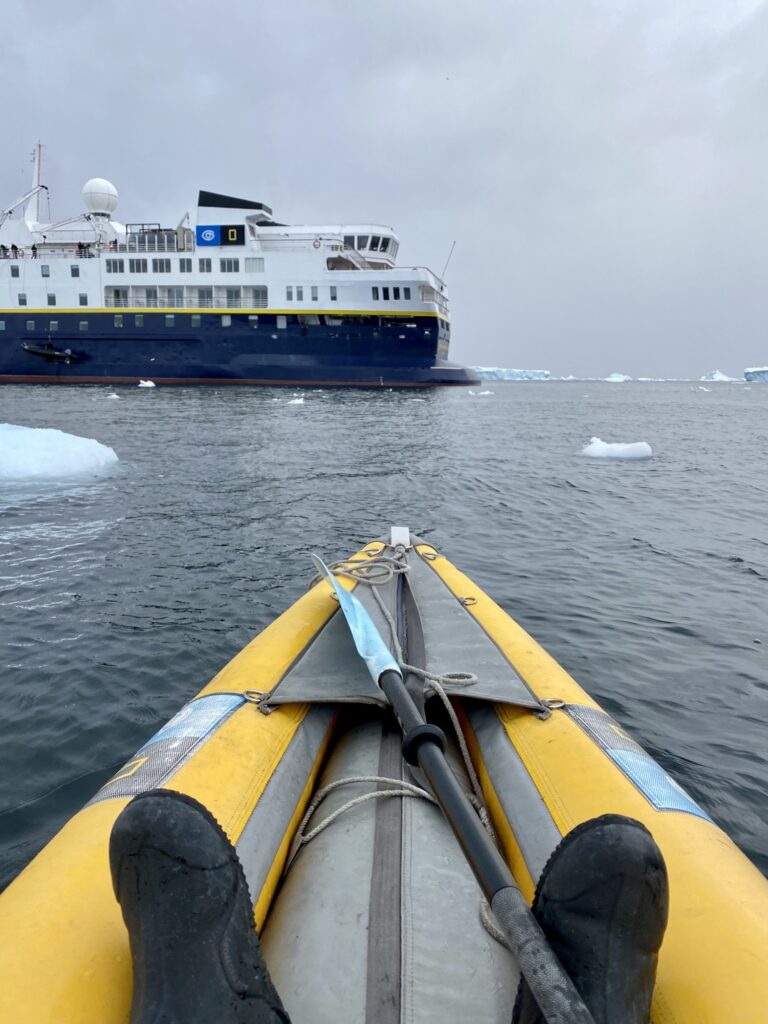
We were part of the last group to go out. It was a little windy and Corey’s skills have not improved over the years. Add in the ocean current and a kayak without a rudder and you get a grumpy Tammy and a kayak that moves in circles. It was difficult to avoid icebergs and after a long 25 minutes, we headed in a little early. At least we can say we did it! It started to snow while we were out there and the conditions were getting colder, so on our way back I figured they would postpone the polar plunge scheduled for the afternoon. Perhaps it was just wishful thinking. I was wrong!
Polar Plunge
The plunge went on as scheduled but just a bit later than anticipated. I signed the waiver, donned a bathing suit and robe and made my way to the mud room as instructed by the Expedition Leader. About 60 other people joined me as we danced, hooted and hollered with nervous energy. We joined in a frigid conga-like dance party that snaked through the mud room, as we stood barefoot and freezing. Corey posted up on an outside deck to take a video. After my feet had already started cramping from the cold it was my turn to step out onto the edge of a Zodiac boat, jump off into the Southern Ocean, then swim back to the platform. The sea was a brisk 31 degrees F. The plunge was different than I had expected and I asked a few clarifying questions, posed for a photo, and finally jumped in. It felt like eternity to resurface through the viscous and salty ice water. But I made it to the platform over to the platform and exited the water, skinning my knee in the process. My feet were throbbing from the cold but I was greeted with a towel, warm blueberry tea, a shot of vodka, and a souvenir patch. Oh the things I’ll do for a patch!
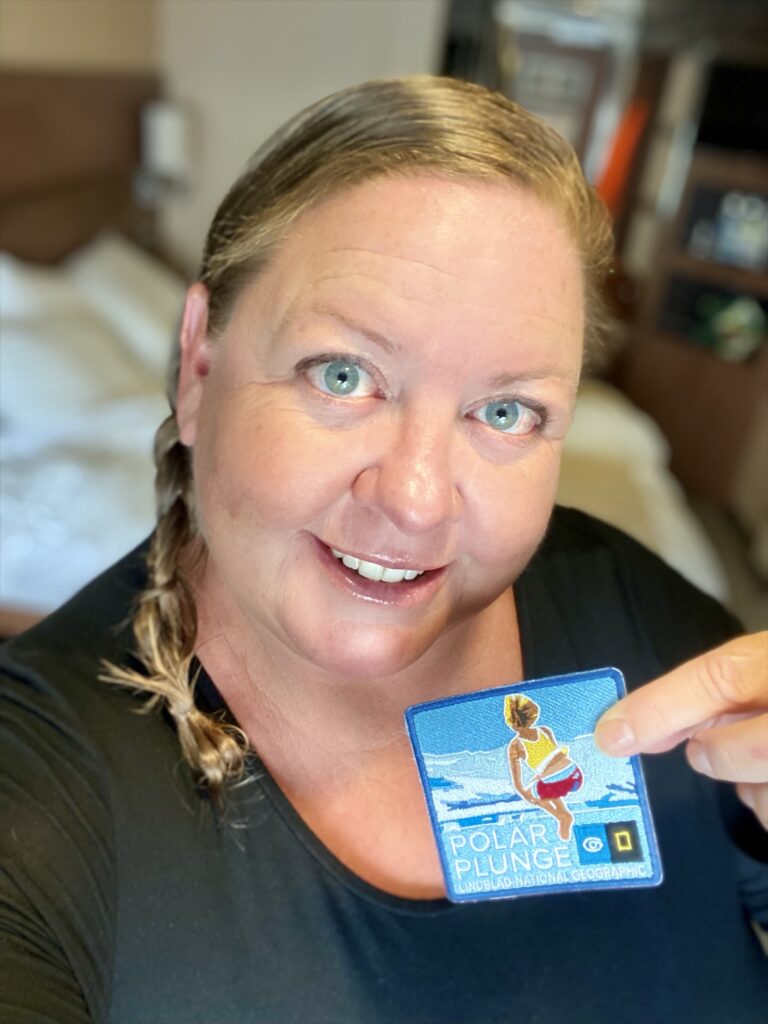
This video shows the highlights from kayaking and the polar plunge. Just another day in Antarctica!!
Day 6
Another picturesque place! By this point of the voyage, everyday seemed like the pinnacle of prettiness. Then the following day would somehow supersede what we had already seen.
Paradise Bay
The ship found an interesting place to stop, resting the bulbous bow right on the rock shelf!
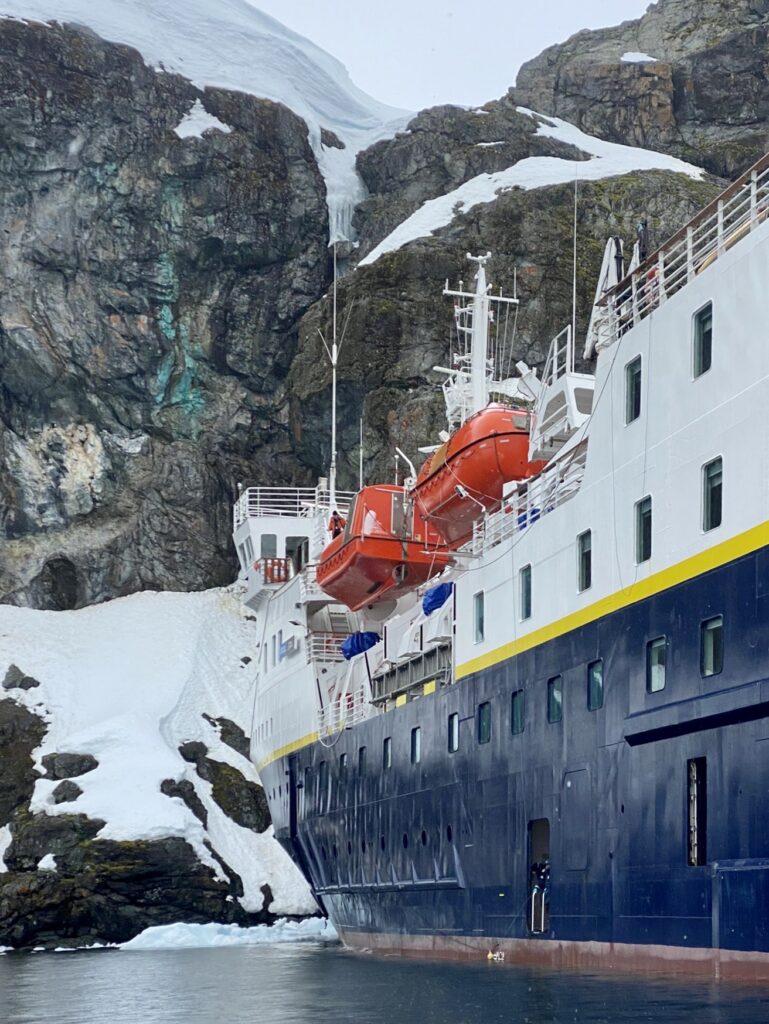
Our Zodiac brought us to a small dock from in front of the Argentinian Brown Station, currently empty until the researchers arrive in January.
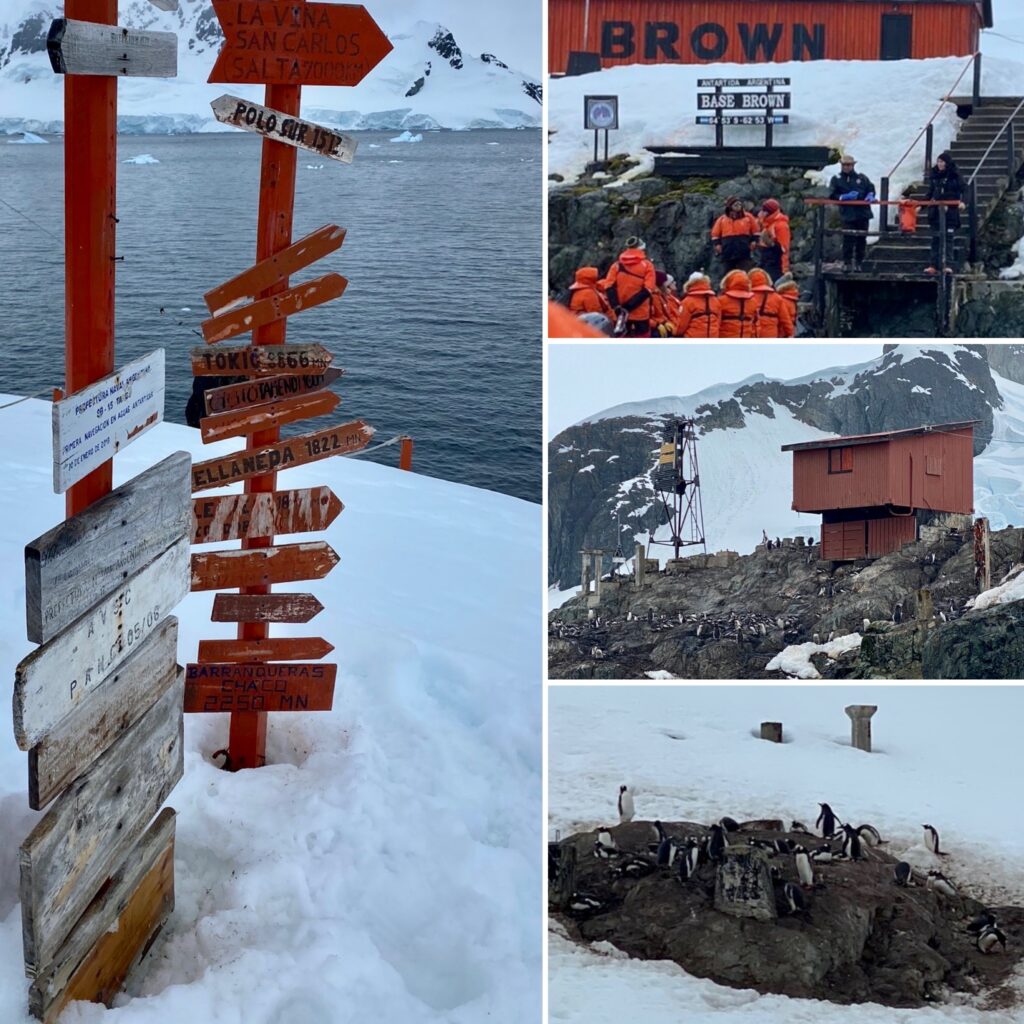
We could explore the base as long as we did not disturb anything or enter any structures. A few penguins were also walking around the base with us.
The path today was a short hike through the snow to a vantage point, then back down a loop to the boat house, where the Zodiacs would return us to the ship.
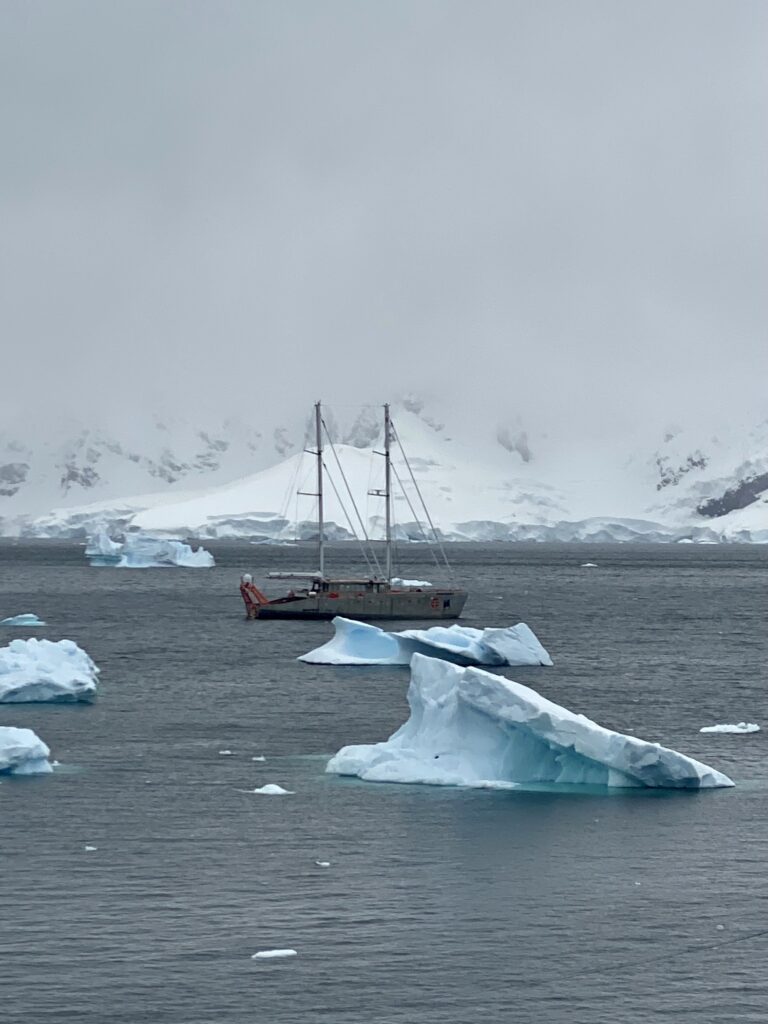
It took me a few minutes to discover the path of compressed snow. Even with polarized sunglasses all the snow looked the same to me. But the snow muted the sound and it was a peaceful experience.
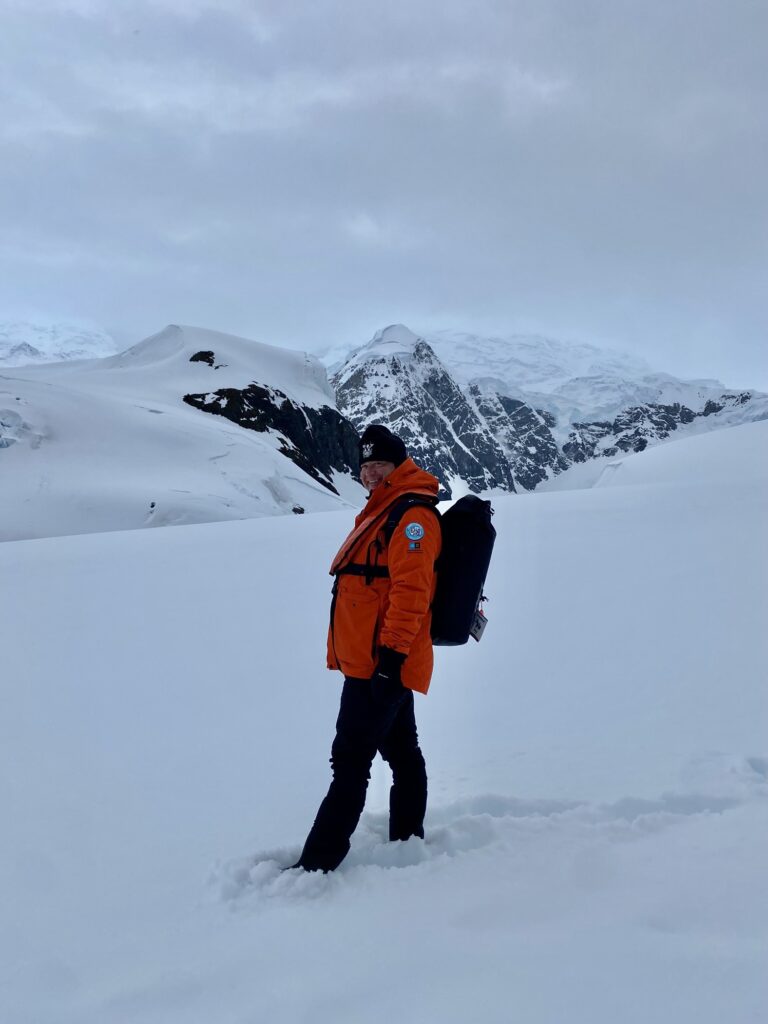
After the hike we continued on a scenic Zodiac ride with Amy around the bay. A nearby glacier had some loud calving, but Corey is the only one who saw it.
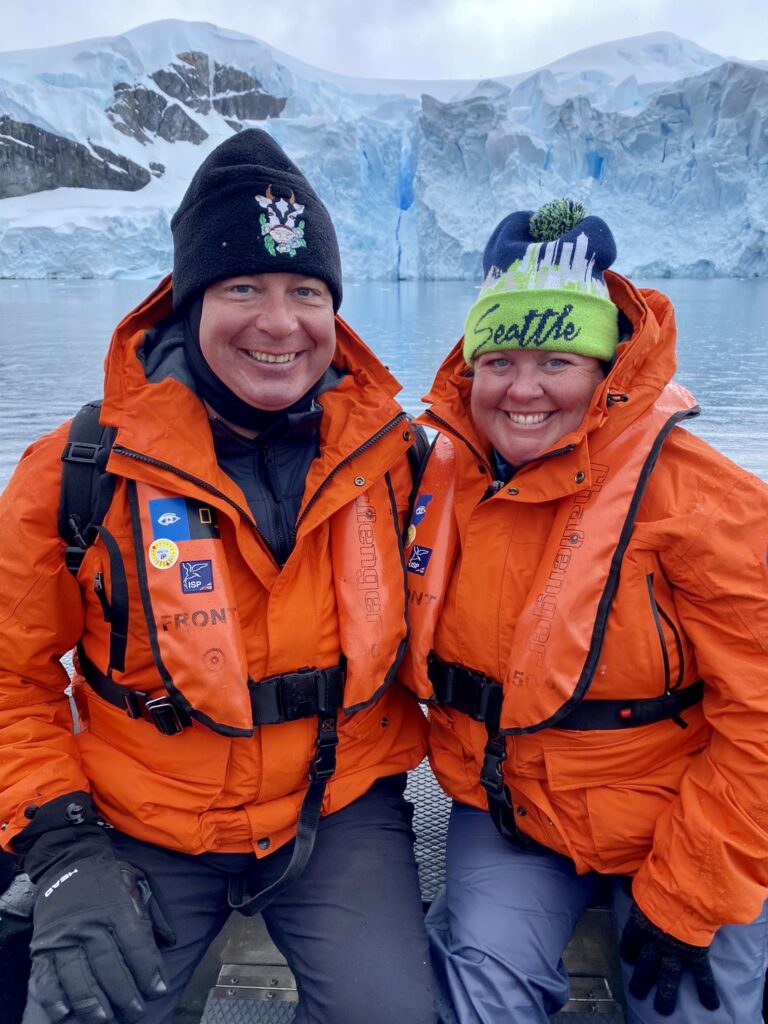
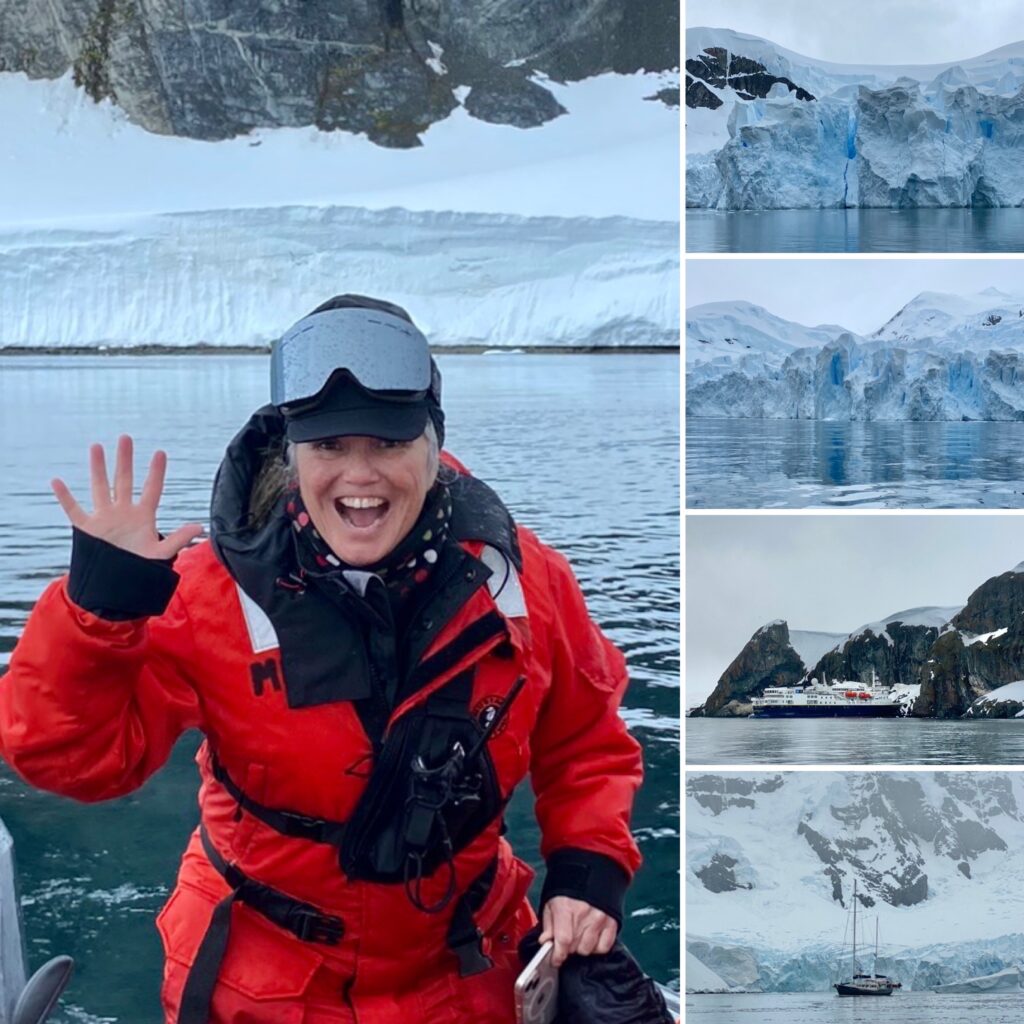
The views were gorgeous, with glaciers all around, and tall peaks touching the wispy clouds.
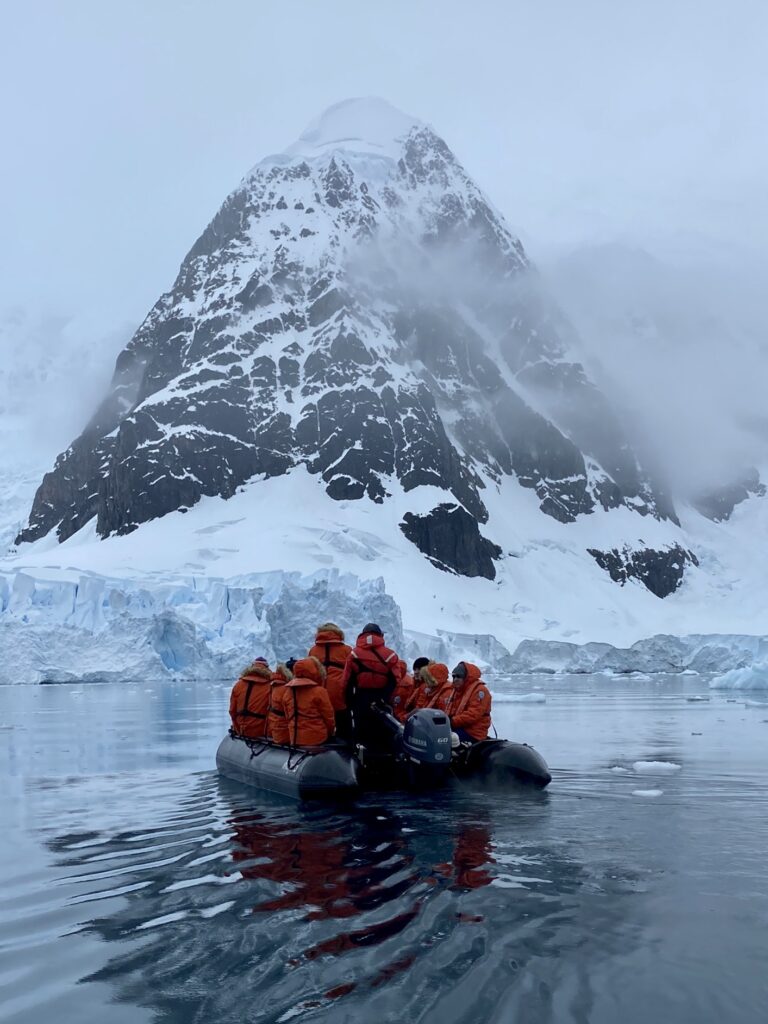
Neko Harbor
The afternoon was spent at a beach landing not far from Palmer Station. Sailing in was a winter wonderland, with the light fog providing a mystical vibe. Here the ship landed on the beach!
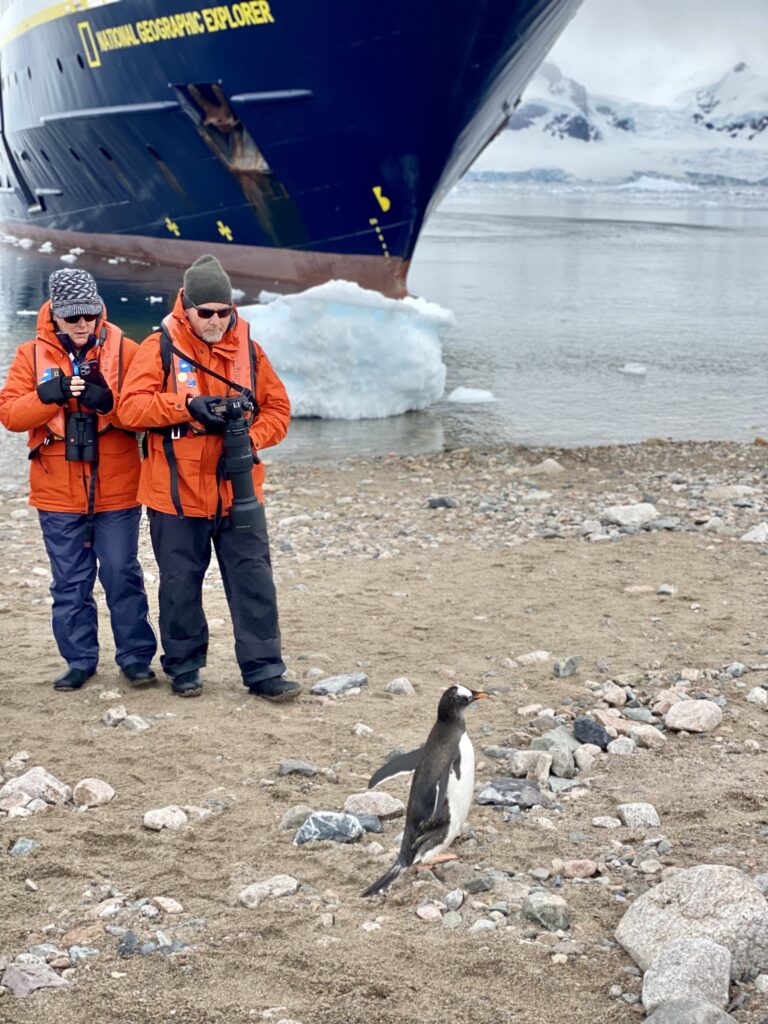
This was our third landing on the continent, and our last chance to step foot on Antarctica before sailing back through the northern islands.
We were introduced to tidewater glaciers, which flow down directly into the ocean. We followed the coned circular path up a hill, around the penguin nesting area, then down the hill near a small bay surrounded by glaciers. We continued, crossing penguin highways, back down to the beach. As we passed, the gentoo penguins would call out with their distinct cooing and bellowing.
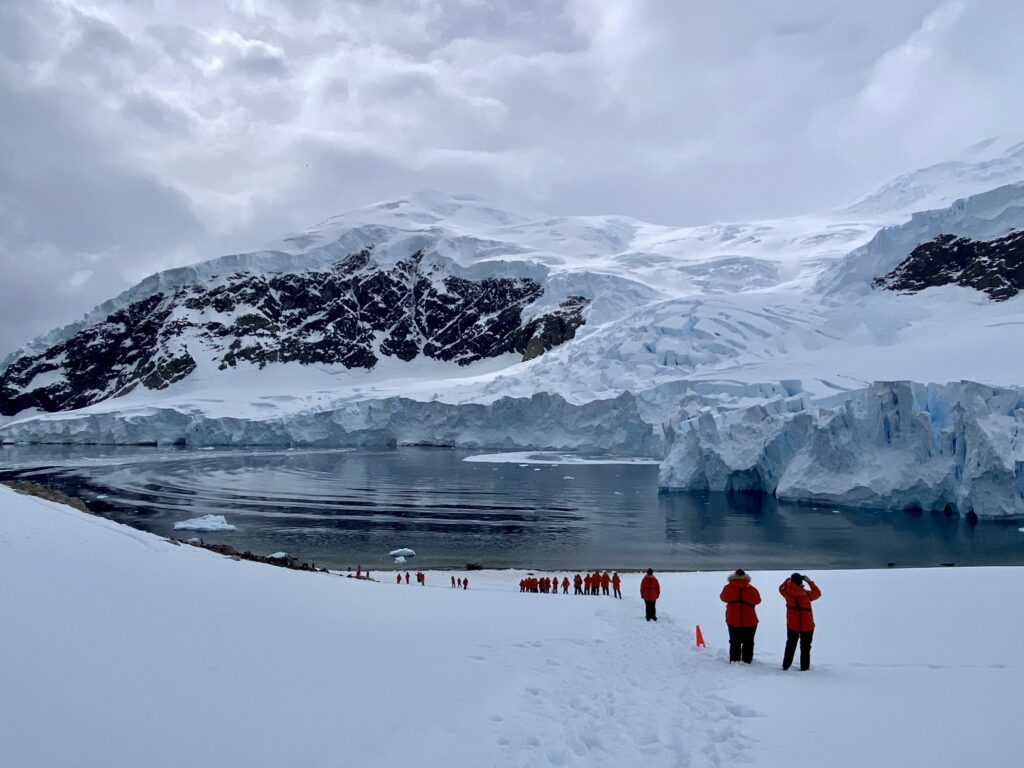
The glacier calved multiple times when we were there, creating an incredible scene. The impact from the falling ice creates a tsunami effect, which can flip Zodiacs that are on the beach. It is important to get off the beach when you hear the crash, as the waves will be coming soon. Most glaciers in Antarctica are receding, but this glacier is actually advancing. It is just cold enough in this area that it snows frequently, and at this point that is adding enough mass to the glacier that it keeps pushing further into the ocean. The glacial ice moves about nine feet per day!
With the ship resting on the beach, the Zodiac ride was a quick shuttle back. Watch this video with the highlights of the day including loads of cute penguins and the glacial calving.
Day 7
Heading north, back to the South Shetland Islands.
Deception Island
This horseshoe-shaped island is the caldera of an active volcano, which last erupted in 1969. A collapsed portion of the caldera allowed the ocean to enter and create a calm sailing area inside the volcano itself. This entrance is known as Neptune’s Bellows due to the wind that flows through it.
Jon, our Expedition Leader, woke the ship up at 6:40 AM, earlier than usual, to announce that we were about two miles from the island and to get up and get out on deck.
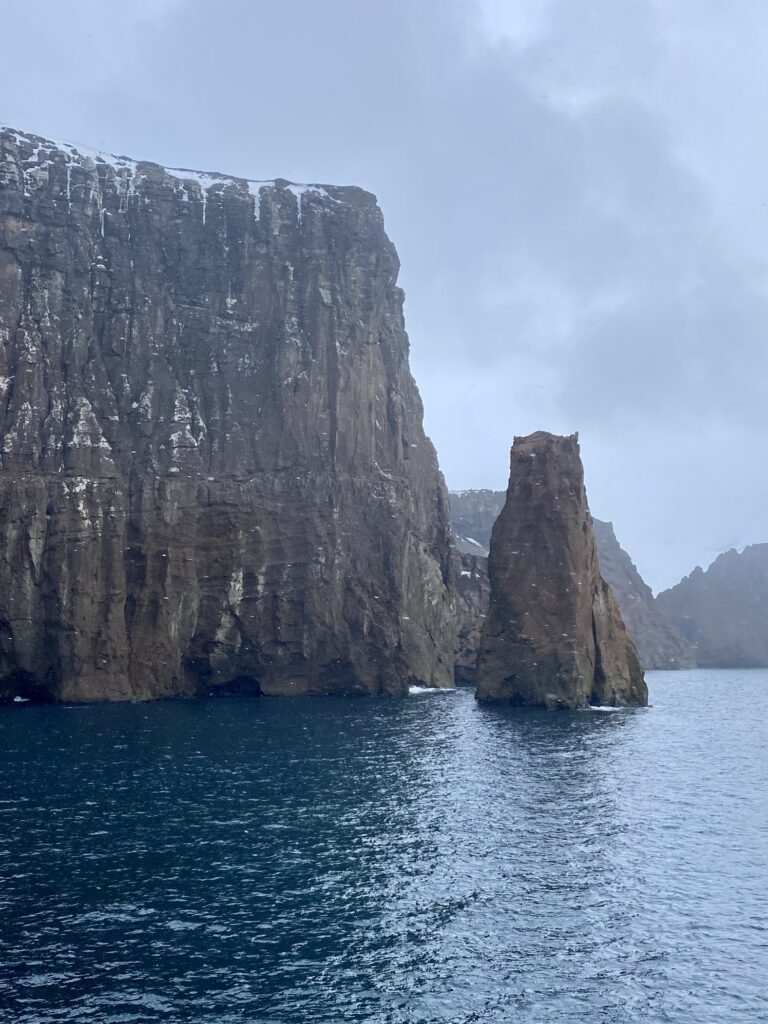
The weather was slightly snowy and cold. Instead of crowding around with everyone else on the bow, we headed aft and had the entire aft deck to ourselves, as we sailed peacefully into the flooded crater.
Passengers had two options for the day. Corey did the long hike, which was a two mile loop up a sandy ridge to a viewpoint. I chose the shorter hike.
I did not expect to see so much black sand in Antarctica. The combination of the snow and sand looked like the patterns of orcas. The scenery was striking, and so different than previous days.

After picking up the long hikers, the ship sailed around the outside of Deception Island. We spotted two other ships nearby but nothing too close. We had hoped to go ashore on the beach of the biggest penguin colony I’ve ever seen, but the winds and surf were too strong for a safe landing. We sailed close and had fabulous views of the beach, penguins, and the black glacier. After sailing in Alaska many times, I am used to seeing dirty glaciers but this was my first time seeing a glacier so dark which was caused by the volcanic dirt/ash.
It’s hard to tell in photos or video but the penguins were nesting all the way up the cliffs!
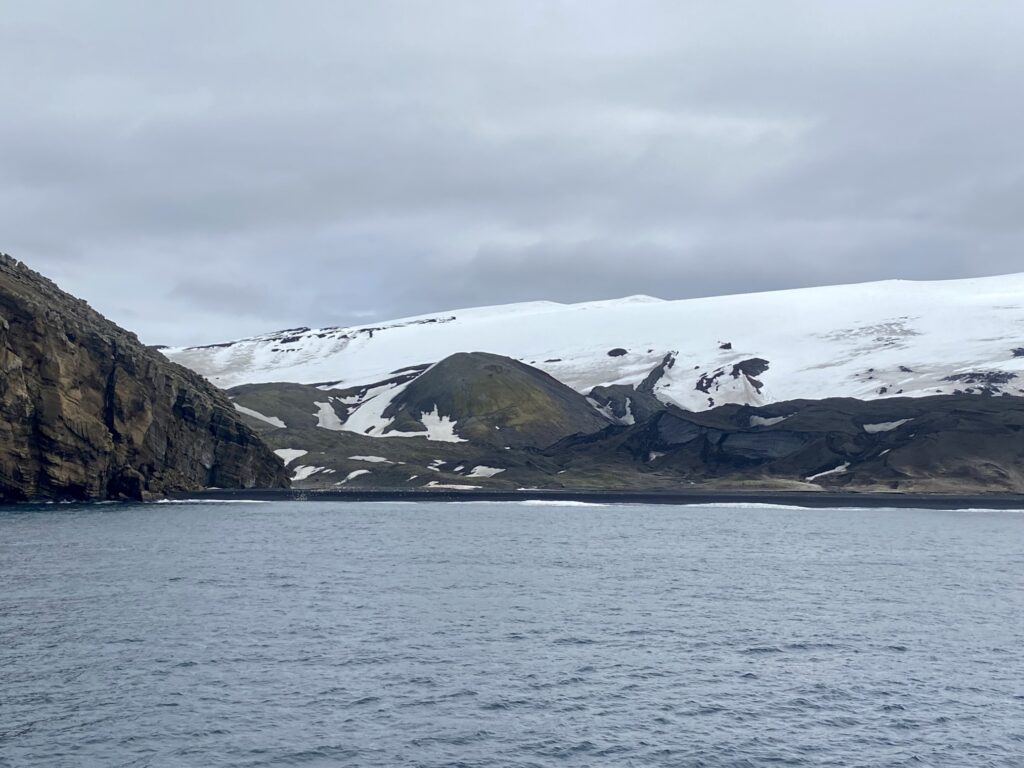
In the afternoon, we sailed by Livingston Island and spent some time watching humpback whales and a fin whale (which is even larger than a humpback).
Watch this video see the highlights from our last landing in Antarctica.
Days 8-9
Drake Passage, again
From there we headed north to return across the Drake Passage. The ship made good timing. It was relatively calm although at times the waves were around 12-15 feet tall, and we again had rocking motion that kept us mostly confined to bed. Good thing we could watch the lectures on the TV in our cabin.
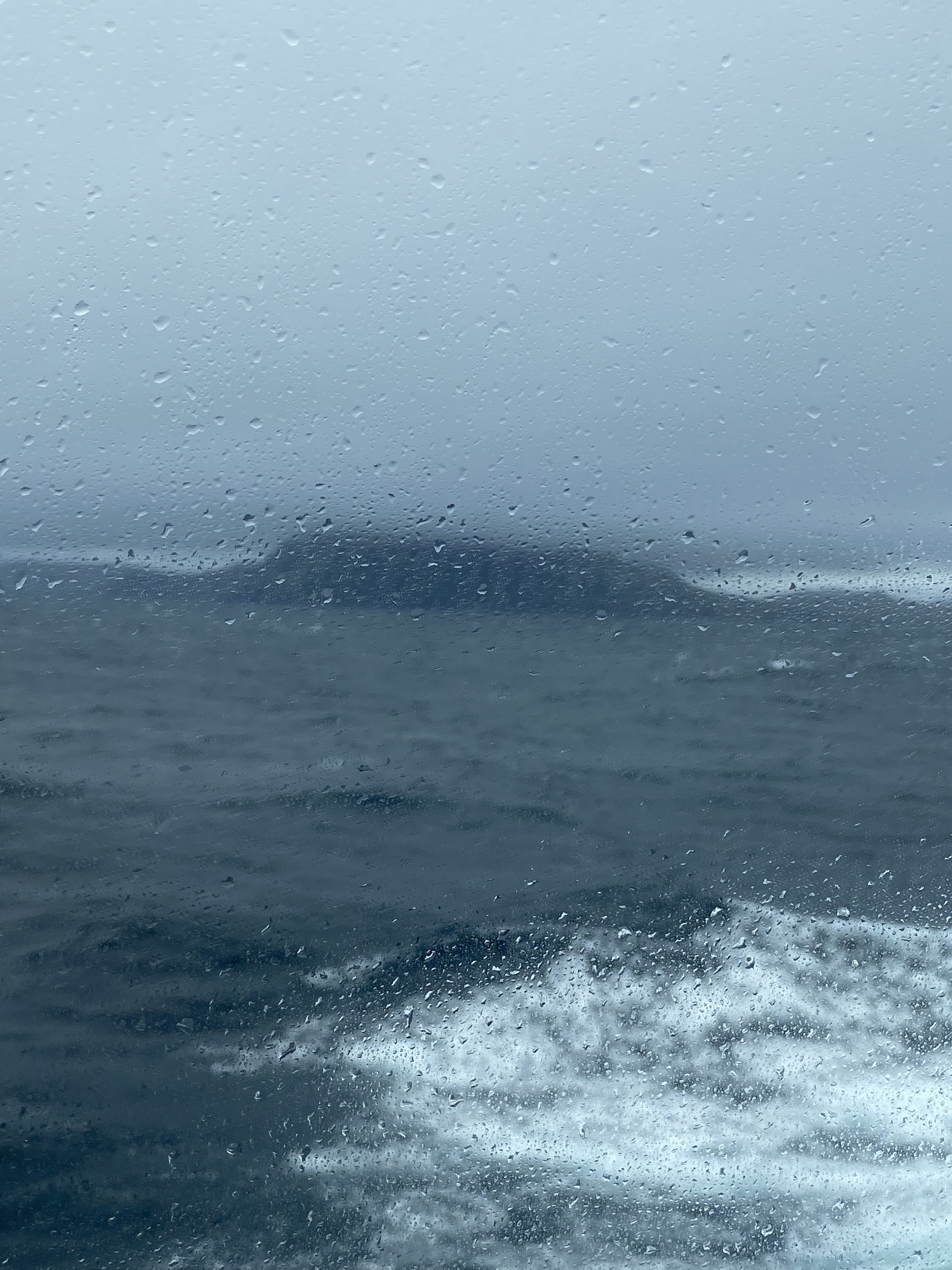
In the early morning, we sailed by the Diego Ramirez Islands. Then later we passed by Cape Horn, where we saw the lighthouse and a statue of an albatross. We learned that the albatross is a symbol of the souls of lost sailors. The Drake Passage has experienced over 800 shipwrecks, and 10,000 sailors lie resting at the bottom of the sea in the world’s largest marine graveyard. It was a poignant moment as albatrosses were seen flying around the ship. We were thankful to have made a safe passage in both directions.
We docked in Ushuaia in the evening, allowing passengers to experience a night in town.
Day 10
Disembarkation is always a harsh call back to reality at an ungodly hour. I was really sad to leave Explorer but if we stayed any longer our clothes would no longer fit since we were being fed so well. We were seen off with a delicious breakfast. The crew stood at the gangway and waved goodbye, as we boarded the buses that would take us off the pier.
Our morning included a quick tour of the Museo Maritimo de Ushuaia, located in the former prison building. We had under an hour to briskly walk through the exhibits before we had to be back on the bus.
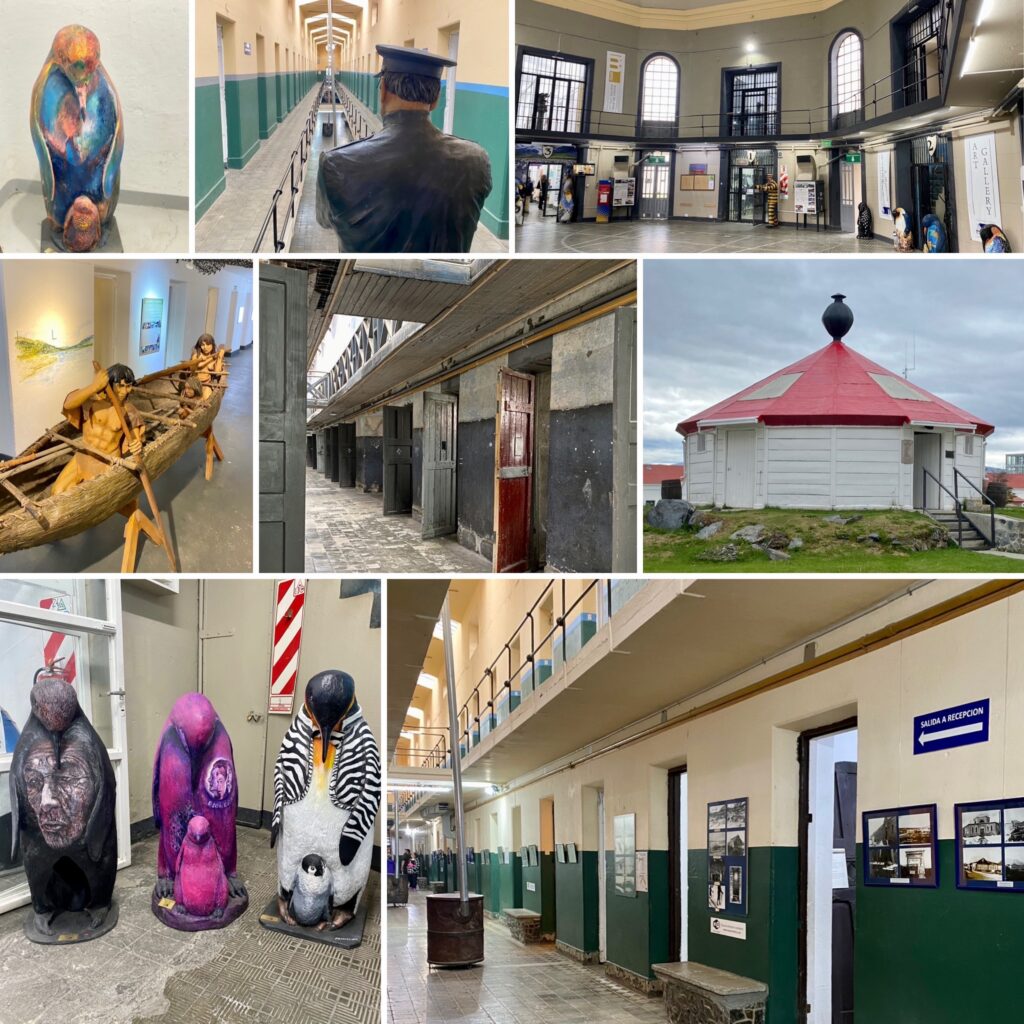
Taking a page from British Australia, Argentina chose to grow the population of Tierra del Fuego by establishing a prison colony. The exhibits showed some of the life of the cold, isolated prisoners, whose existence in this building was eloquently conveyed by a sign: “Each crack and each deteriorated corner tells a story of time, evoking a feeling of melancholy that invites us to reflect on the ephemeral nature of all things.”
The bus dropped us at a hospitality room in a local hotel, where those passengers waiting for the bus to the airport were able to eat and drink. Since our lodging was ready, we chose to finish our trip and head that way.
Our Experience
Words cannot express the immense gratitude I feel for being able to go on this journey. Many thanks to Alison Yarne for helping us achieve this dream and to her partner Brian for the great advice. At times the experience was majestic, dazzling, adventurous, and amazing.
There are around 20 million penguins in Antarctica, so while we saw many of them, we hardly scratched the surface!
National Geographic Explorer
The ship was built in 1982 and was purchased by Lindblad in 2008 and significantly renovated. The captain takes pride in his ship, and part of his presentation of the vessel showed the scope of the renovation. Some of the employees have been onboard since the purchase, and others for many years. Lindblad appears to take care of their employees based on their longevity, and everyone had a high sense of customer service.
Activities
When not stomping around in the snow or cruising through icy bays we were kept quite busy with learning opportunities and an abundance of multi-course gourmet meals.
In addition to multiple subject matter experts (naturalists, professional photographers, divers, a penguin scholar, etc.), we had a special guest speaker: Christian Cooper, a self-proclaimed bird nerd. A famous birder from New York City, this was his first trip to Antarctica, and his enthusiasm for birds was infectious.
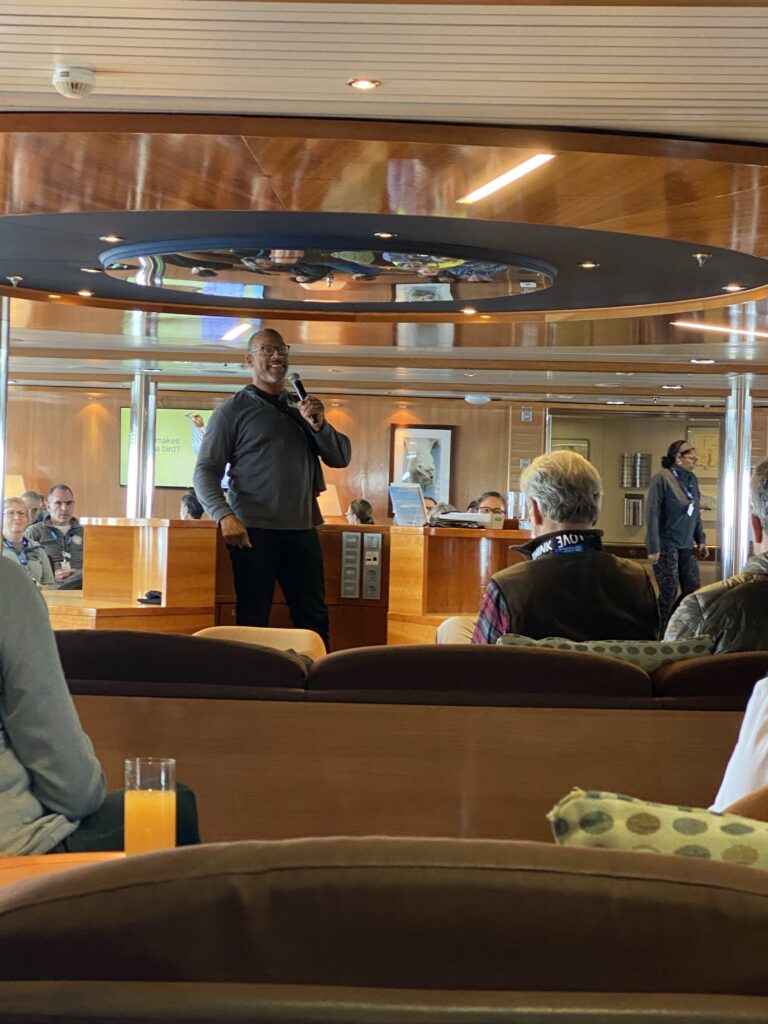
Most of the Naturalists are part-time, keeping the professional “day job” that they are experts in. This enables them to educate us on what they do the rest of the year. On a small ship like this, the staff is also accessible for questions or further discussion. Every dinner, these experts would spread to the empty seats in the dining room to share their wisdom and personalities with the guests. Before dinner, all guests, Naturalists, and Expeditions Staff gathered in the lounge for a “recap”. It was less of a rehash of the day’s events, and more like an opportunity to socialize, connect with others, and learn about the following day’s itinerary.
So many people worked hard to ensure every guest had a wonderful trip, no matter any physical limitations. There was always an option for all abilities, and the physical demands were well-communicated.
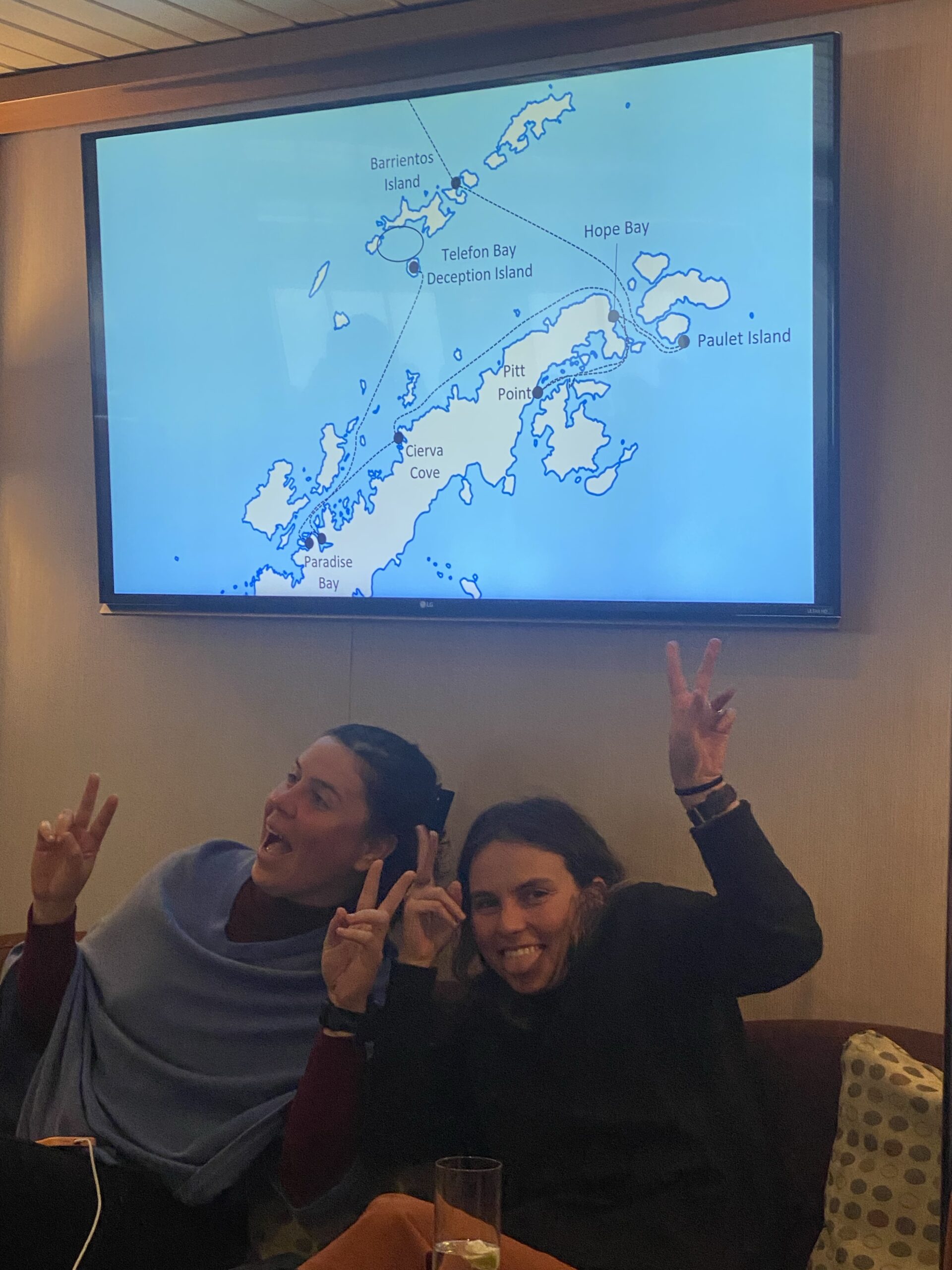
Corey wished there were more opportunities for challenging hikes. There were abundant opportunities for wildlife viewing, and those short paths were well-delineated with cones. On multiple occasions, it seemed like there was the potential for hiking further, but it was not part of the course for the day. The one “long hike” was only two miles and 500 feet in height, which compares to our morning walks in hilly cities like Lisbon and Valparaiso. For Antarctica, the allowed areas of travel are quite limited to protect the terrain and the wildlife. Expect to have an amazing set of experiences, but do not expect anything resembling a serious winter hike.
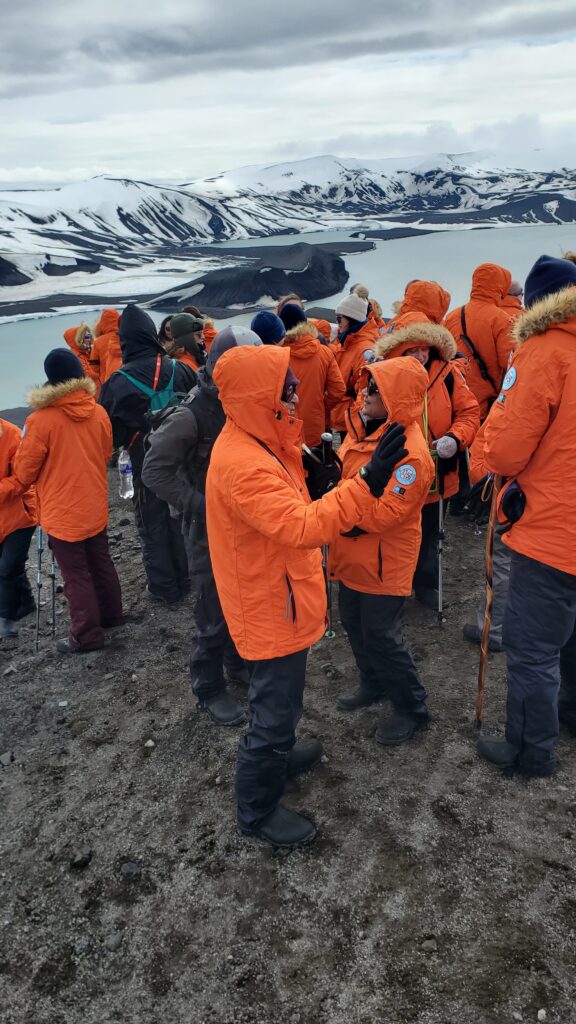
The Food
Every meal was prepared with care and the menu changed daily. Breakfast was a buffet filled with options, including eggs cooked to order. Lunch and dinner were off a focused menu, typically themed toward a specific type of cuisine.
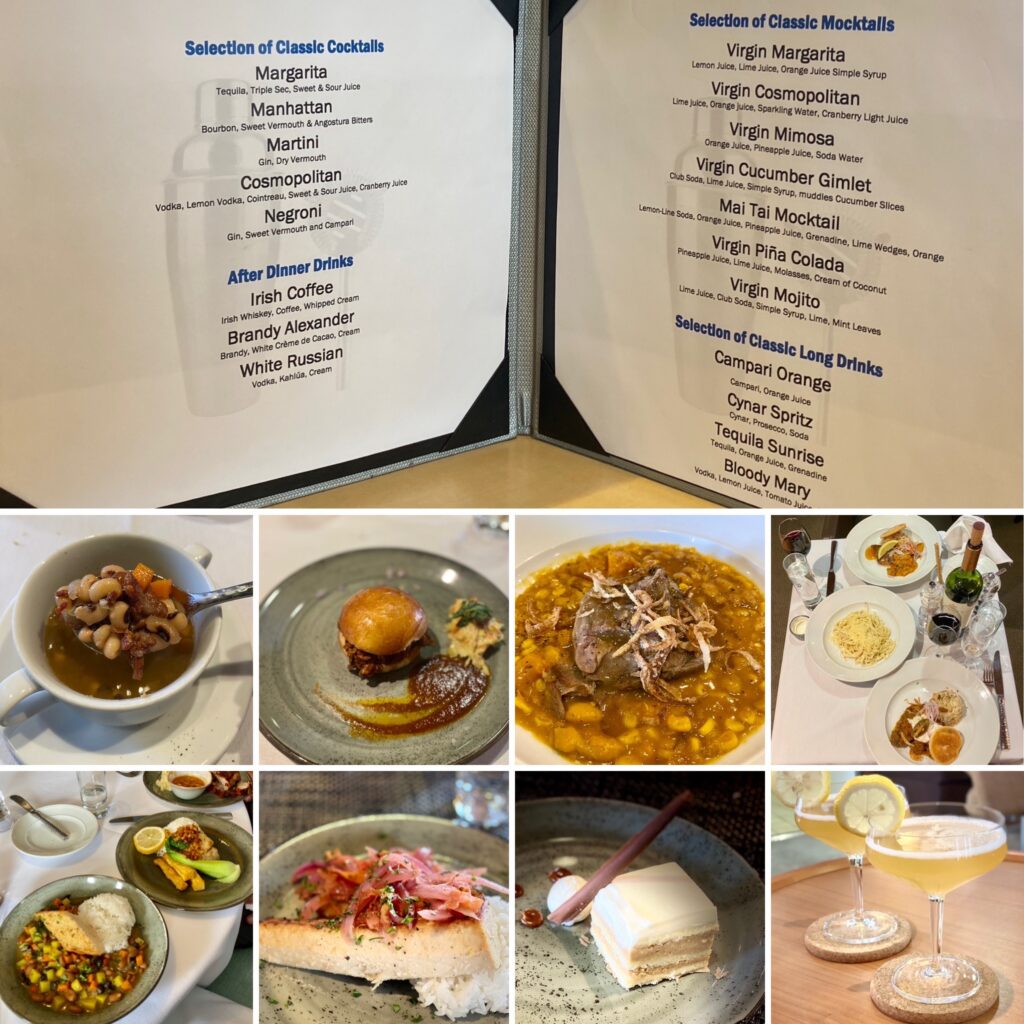
For us, each meal involved some negotiating between me and Corey as we figured out which choices we would use to build our three-course meal. Everything was scrumptious, balanced, and full of flavor. A white and red wine were liberally poured each evening, and other complimentary bottles were available on request.
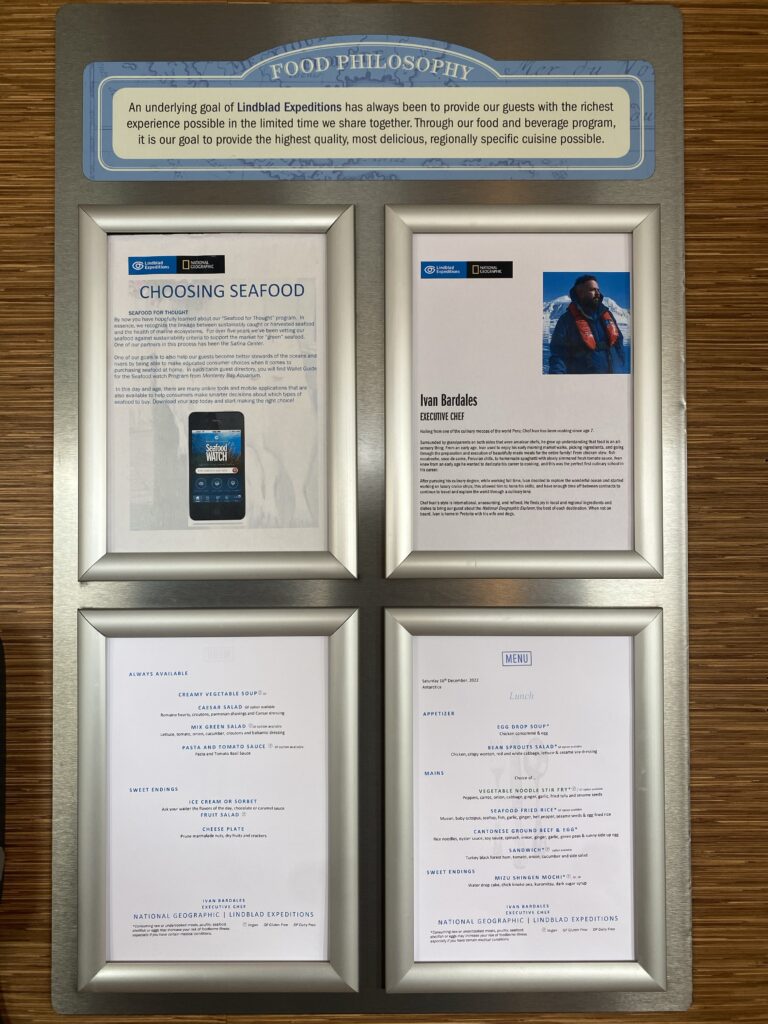
Final Thoughts
We had an incredible time reaching the Seventh Continent, learning about the ecosystem and the human history, and exploring what we could. Lindblad provided an experience where every day was enriching and entertaining. We would consider other small ships for destinations like the Galapagos or the Nile River, and we would absolutely take another Lindblad vessel.
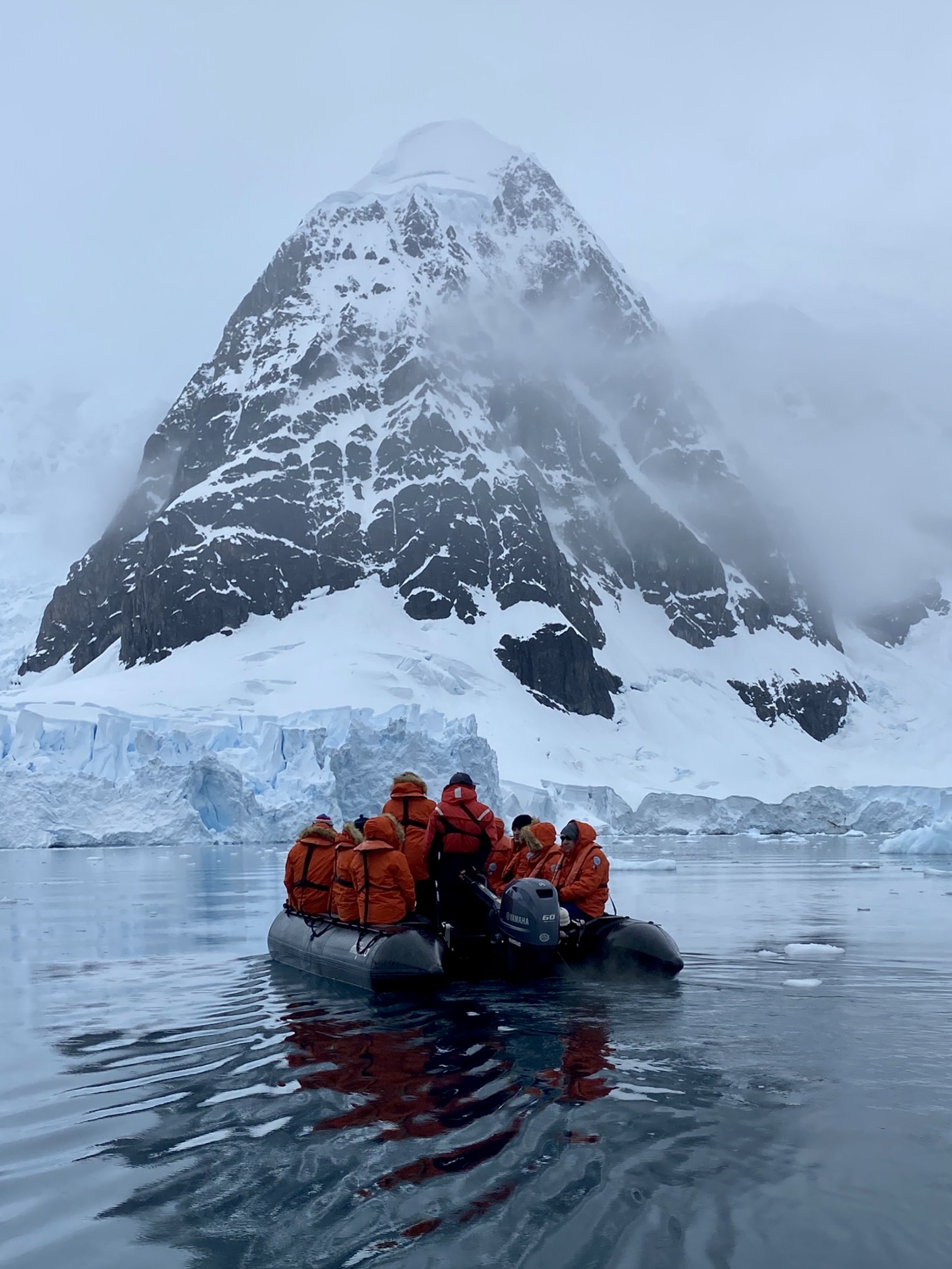
Fantastic photos, feels like I’m right there with you two. The mountains are so majestic and HUGE. You two definitely had a full itinerary as well. What a beautiful way to end 2023!!! Antarctica (check).
Hello Number 1 Fan!! It was a great way to end a fabulous year of travel. It still feels unreal to me….I guess we have to go back!
What a great blog post! I’ve gotten a little behind in your posts, but have loved reading about Argentina and Brazil too! Can’t wait to hear about Africa. ❤️